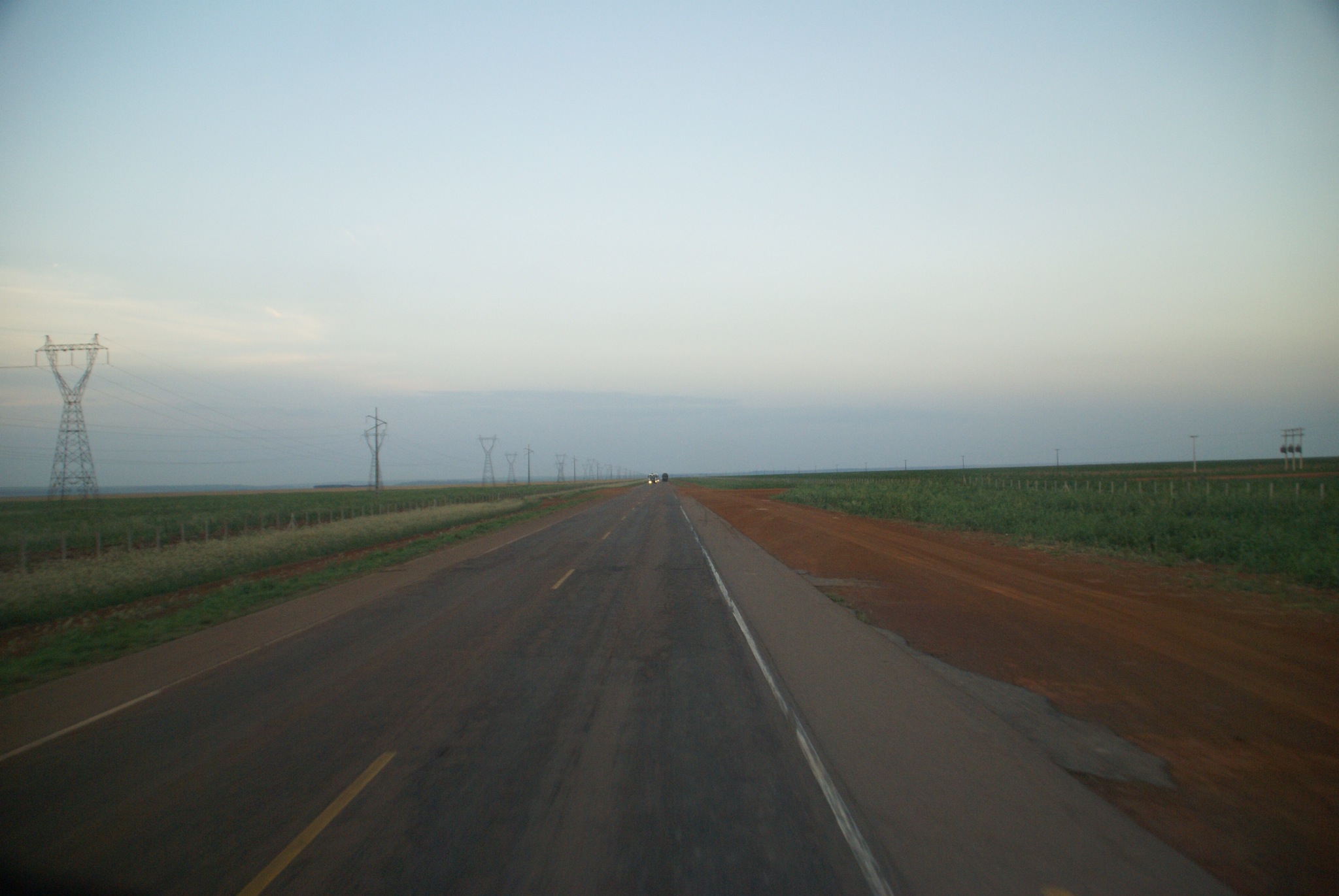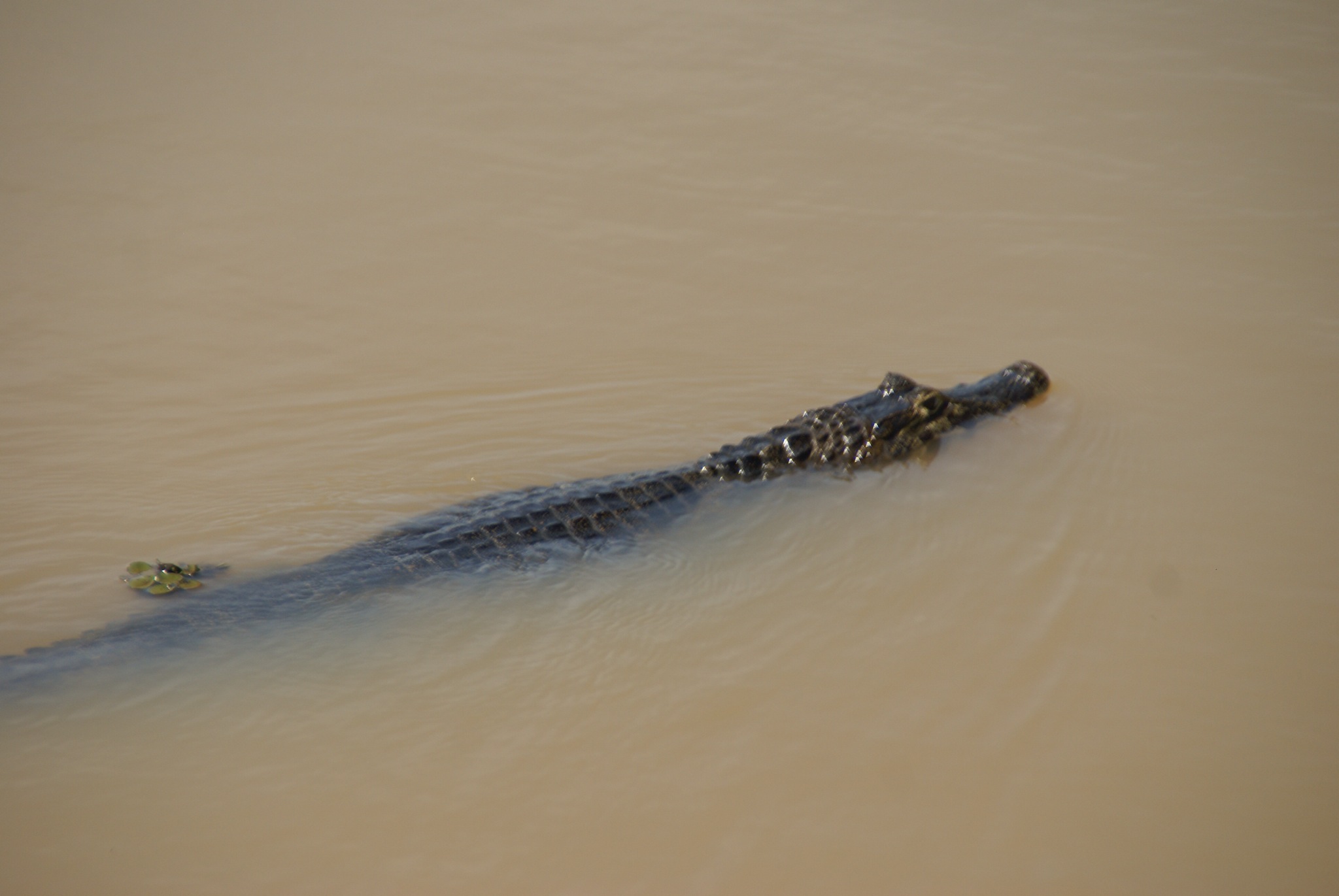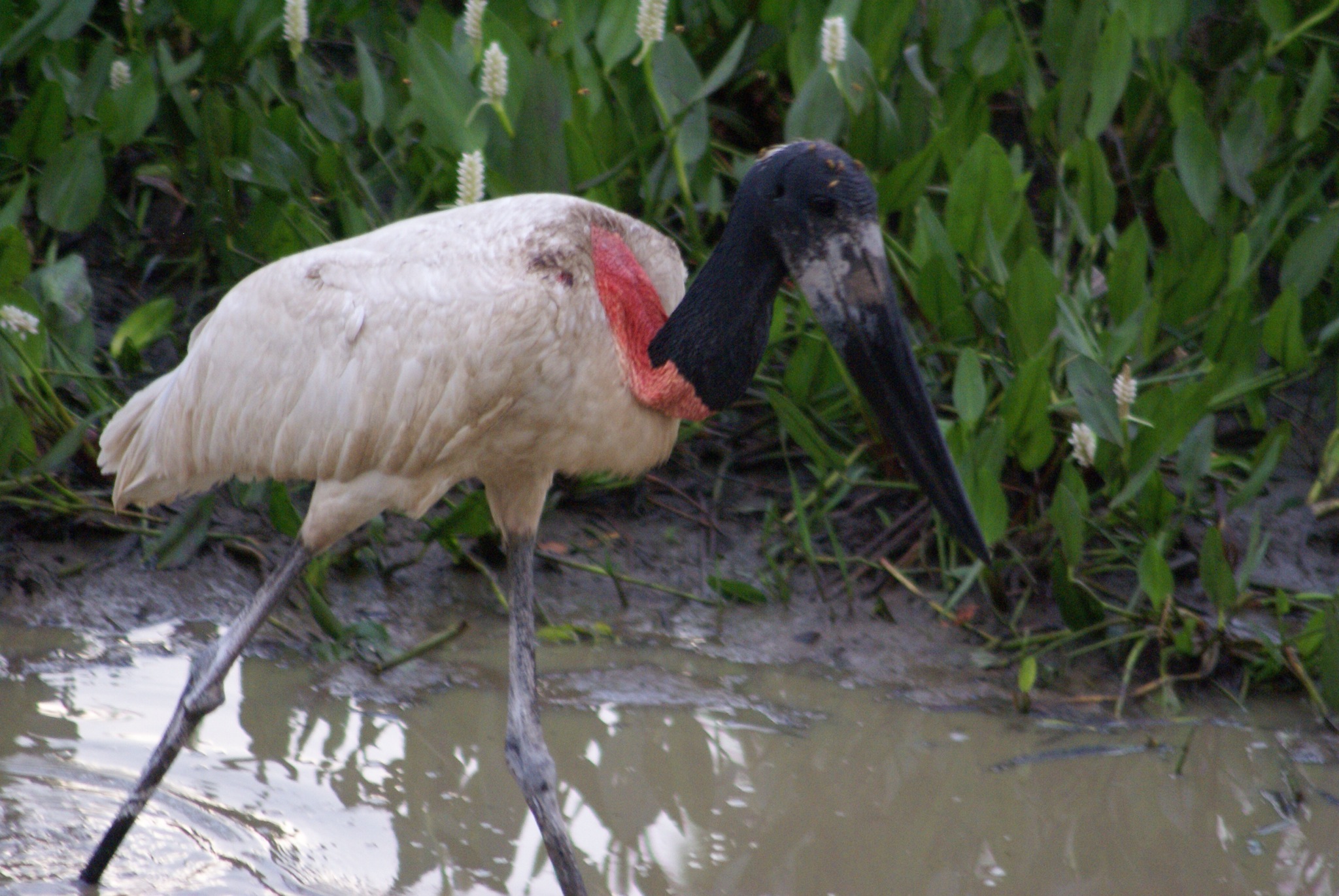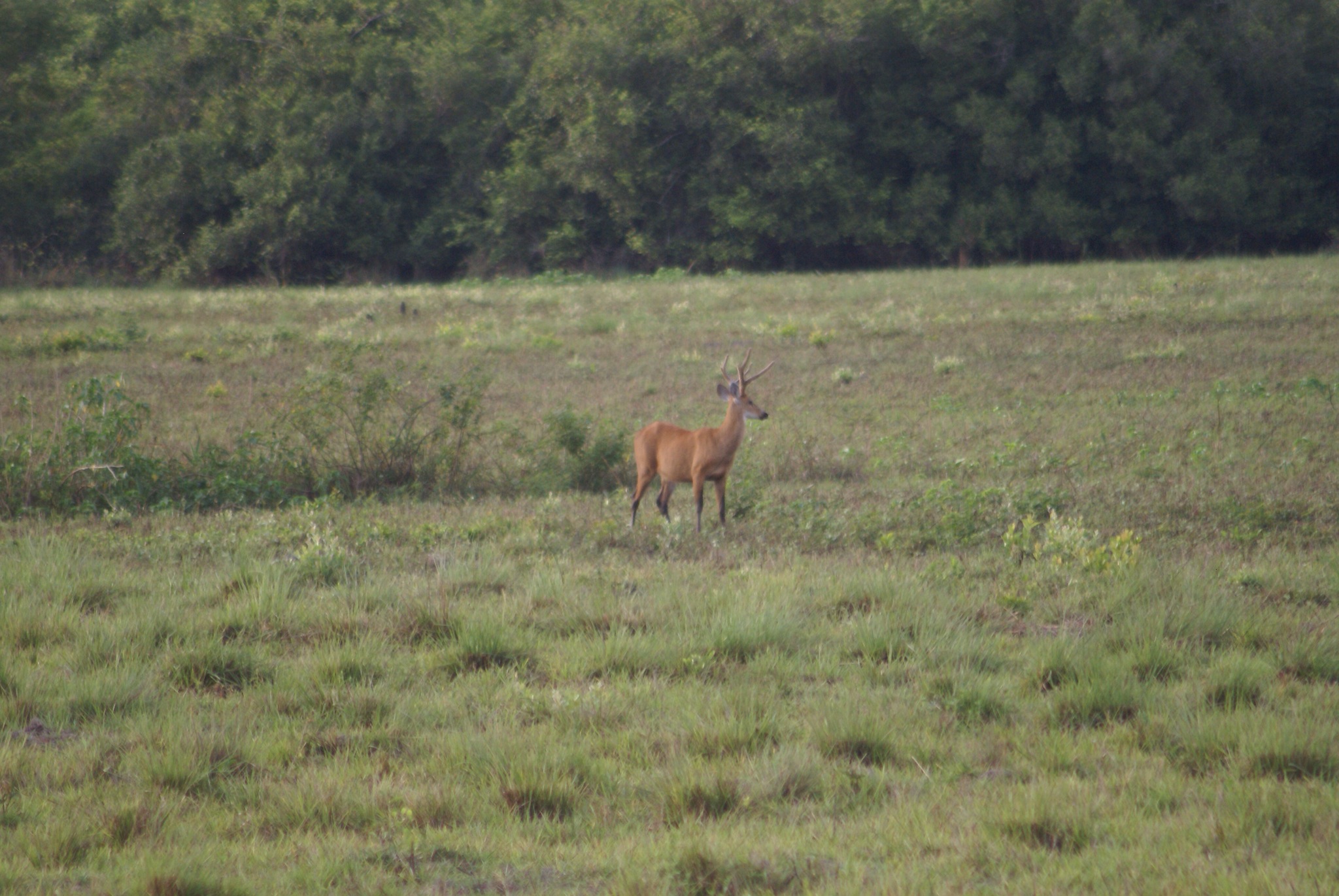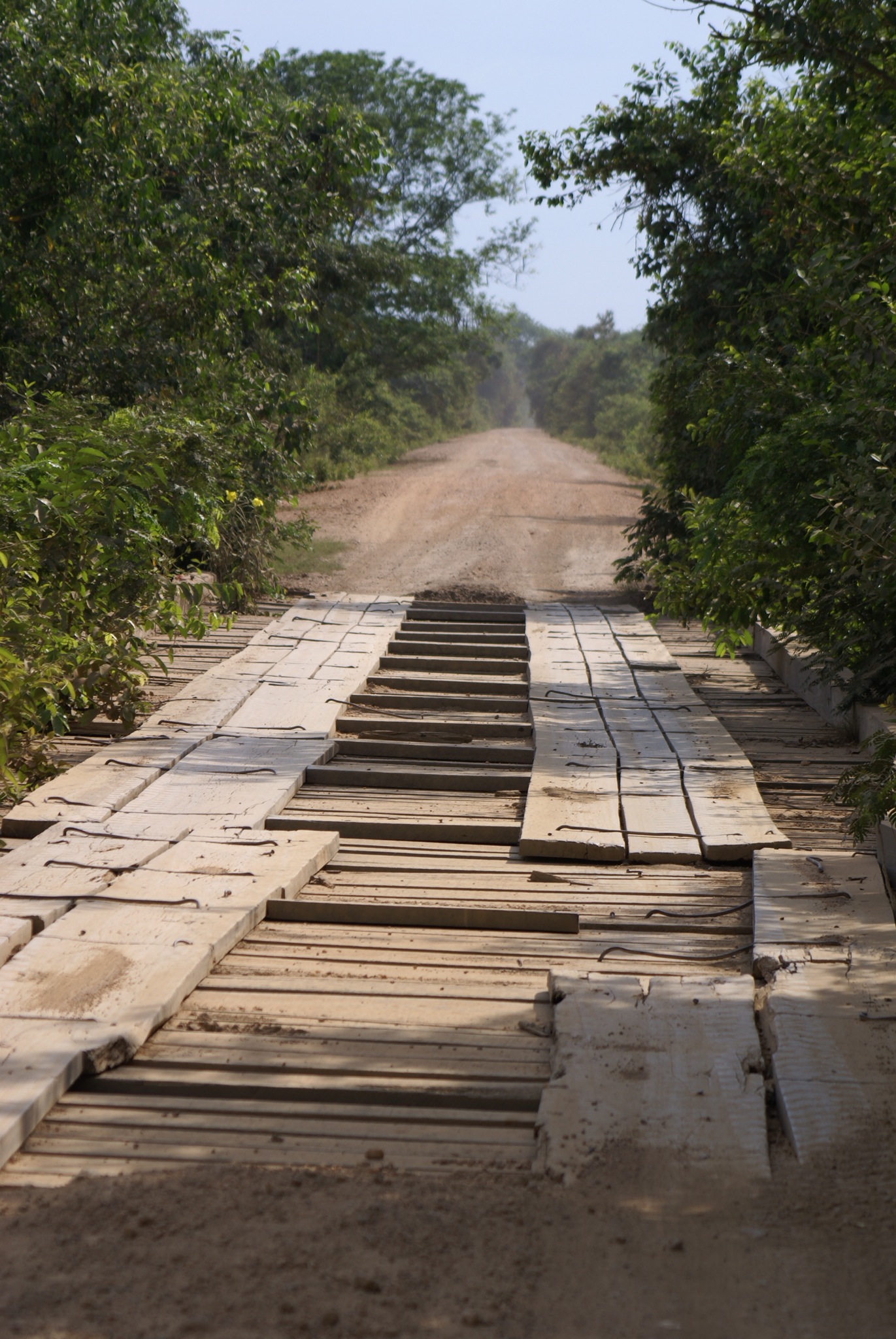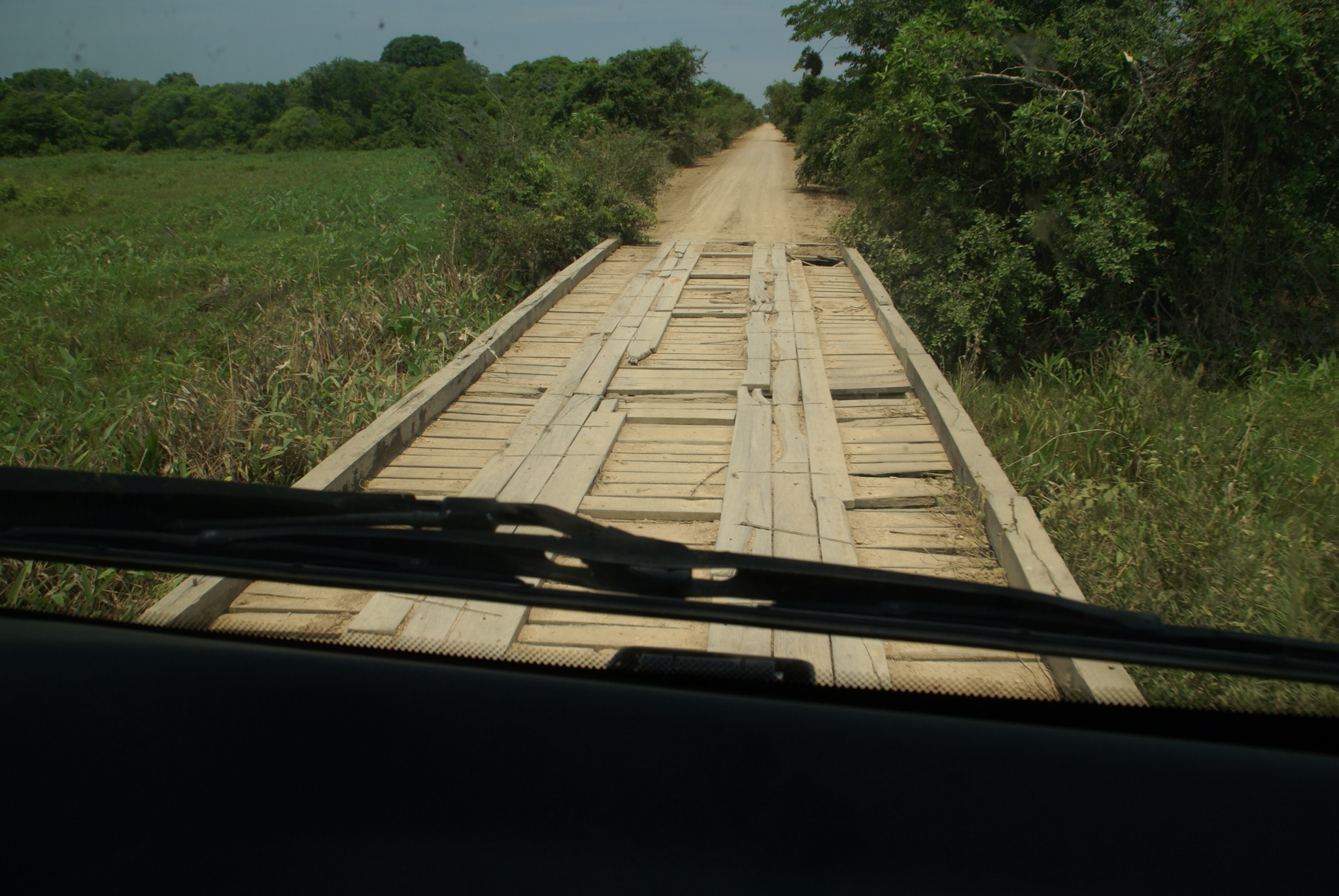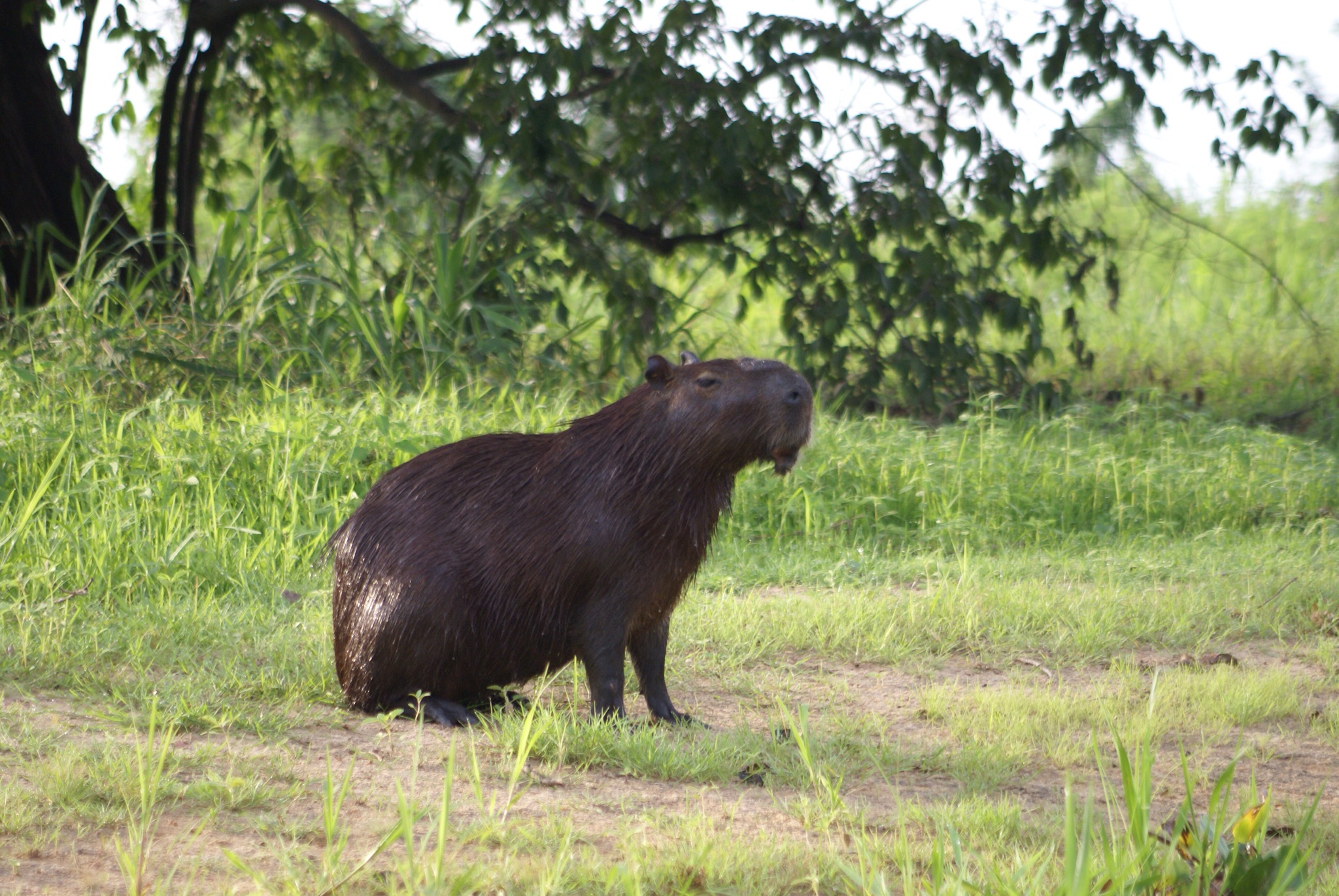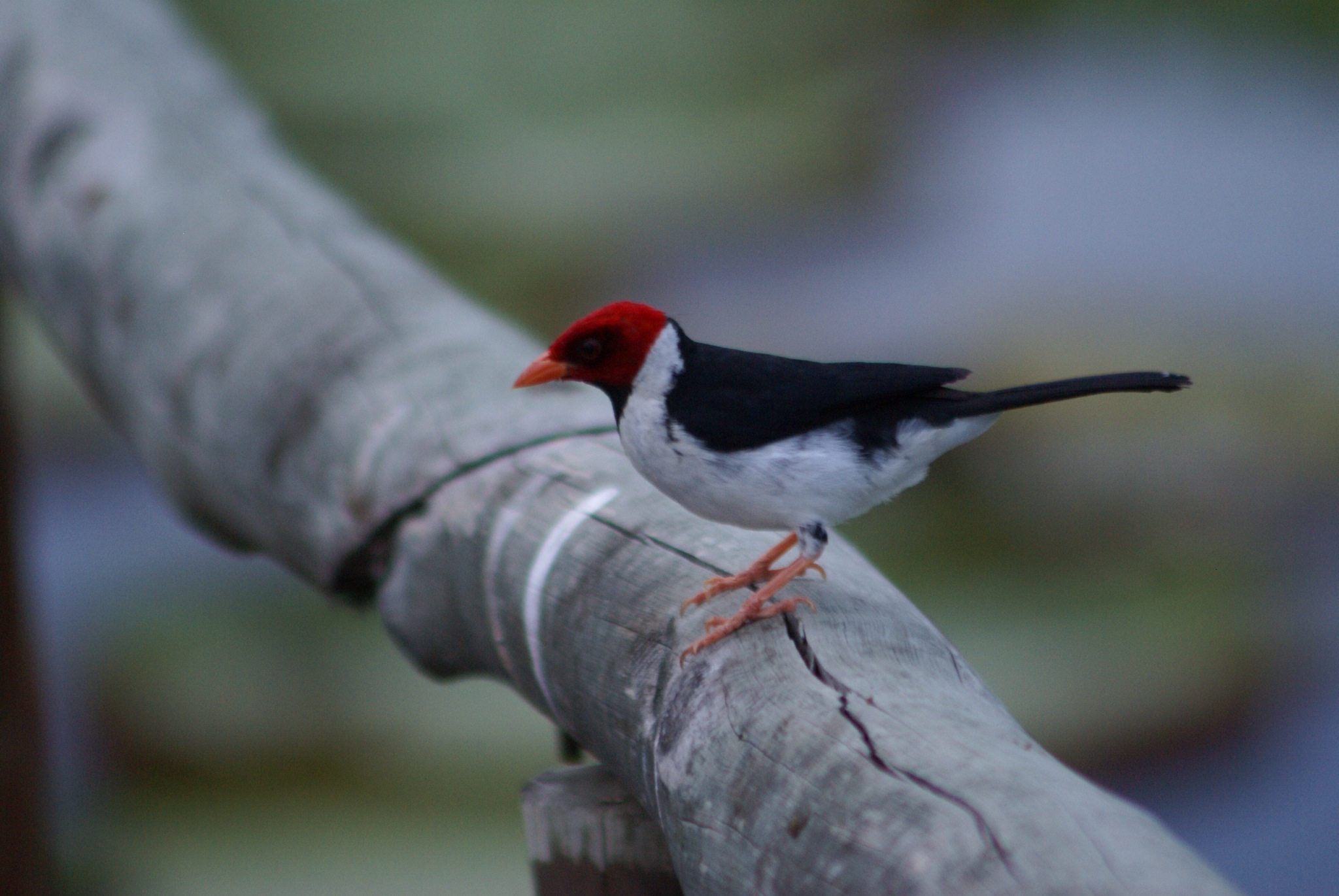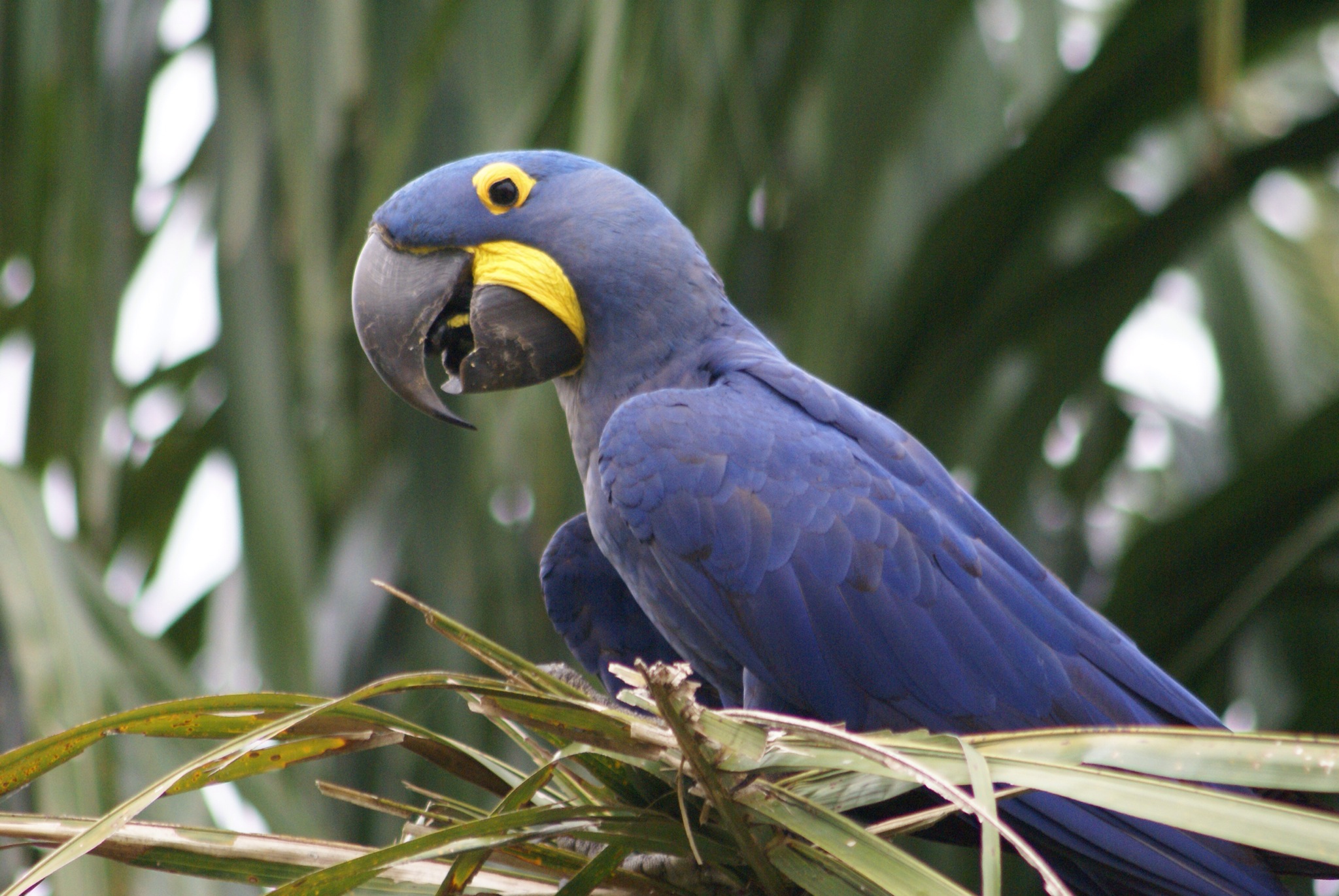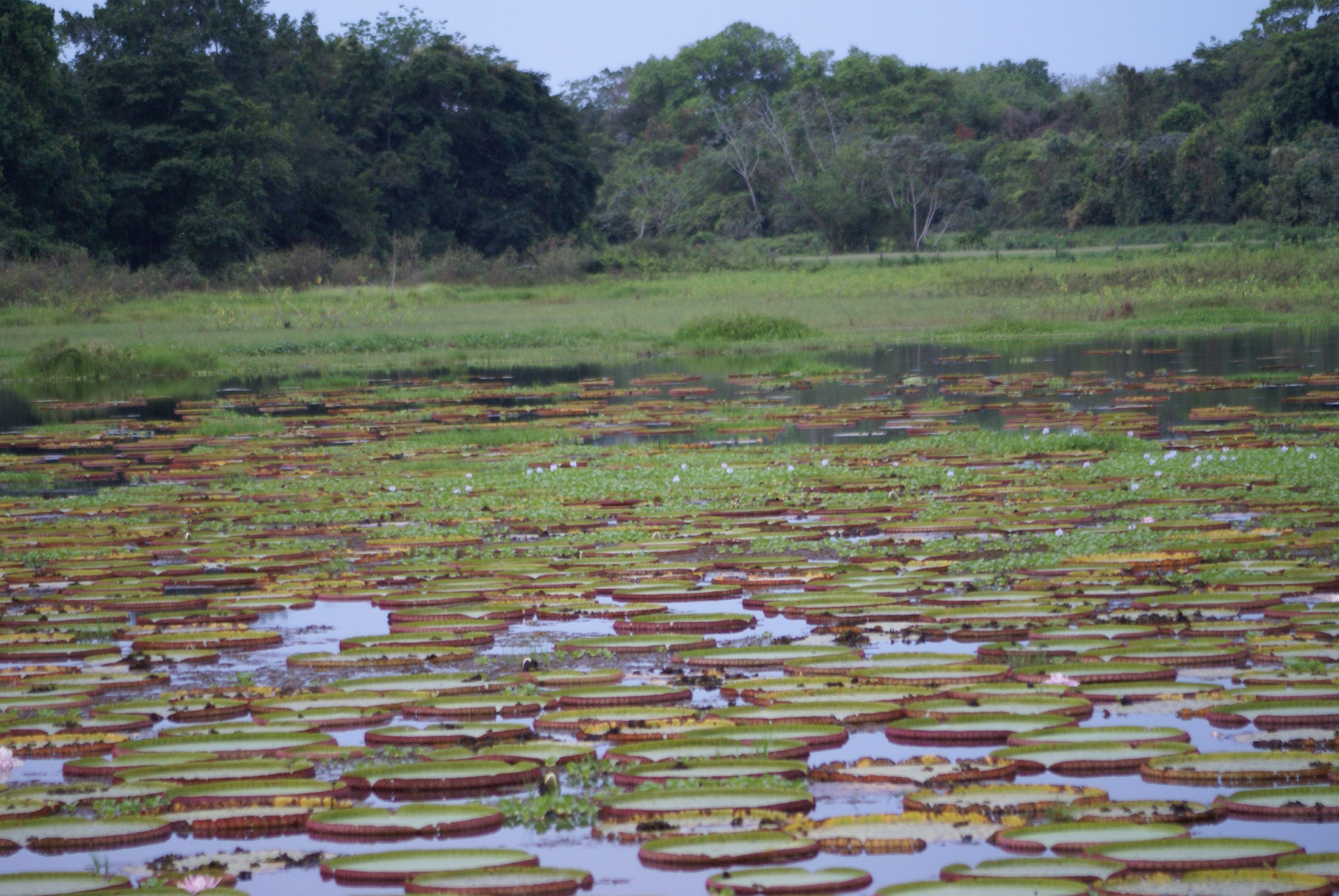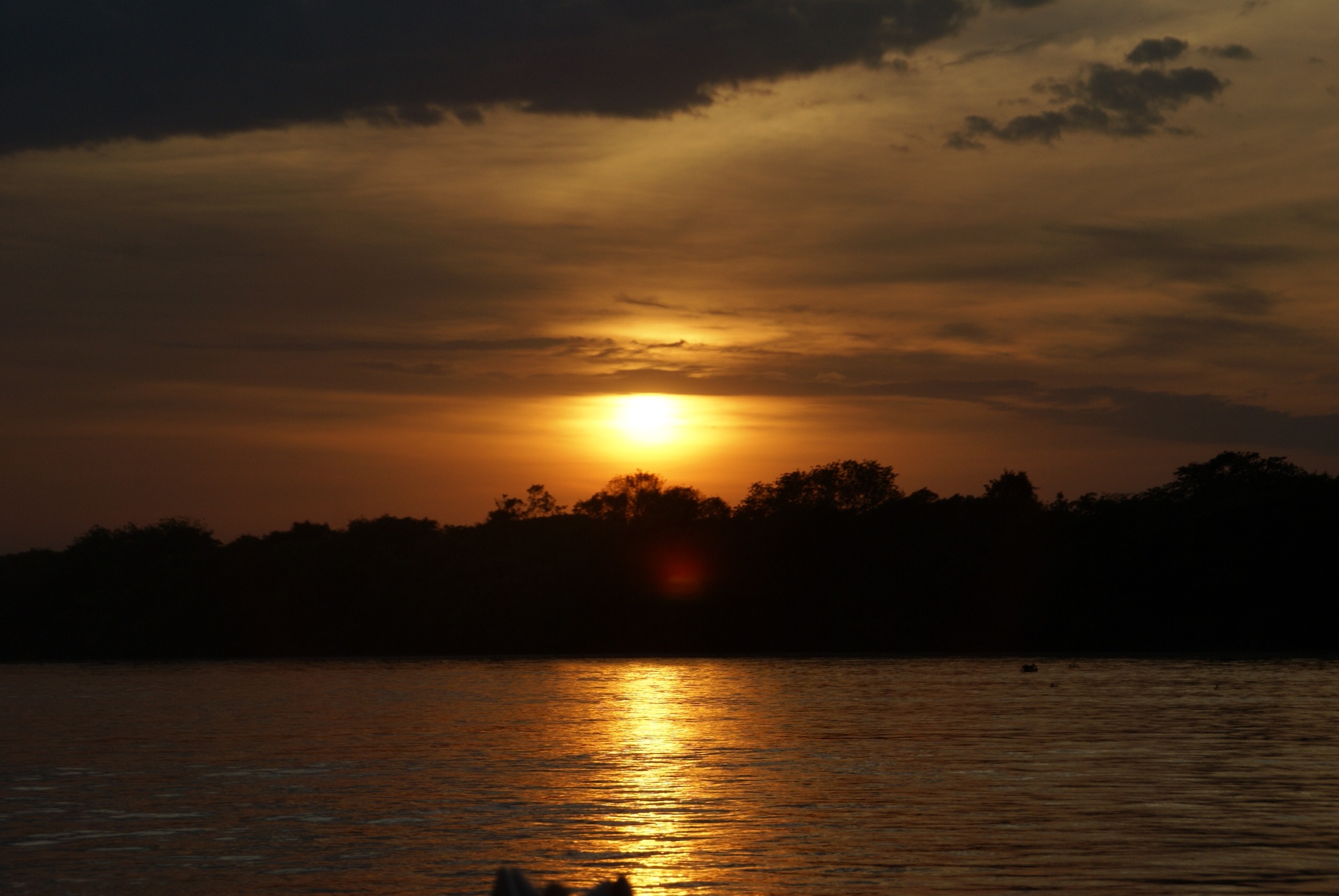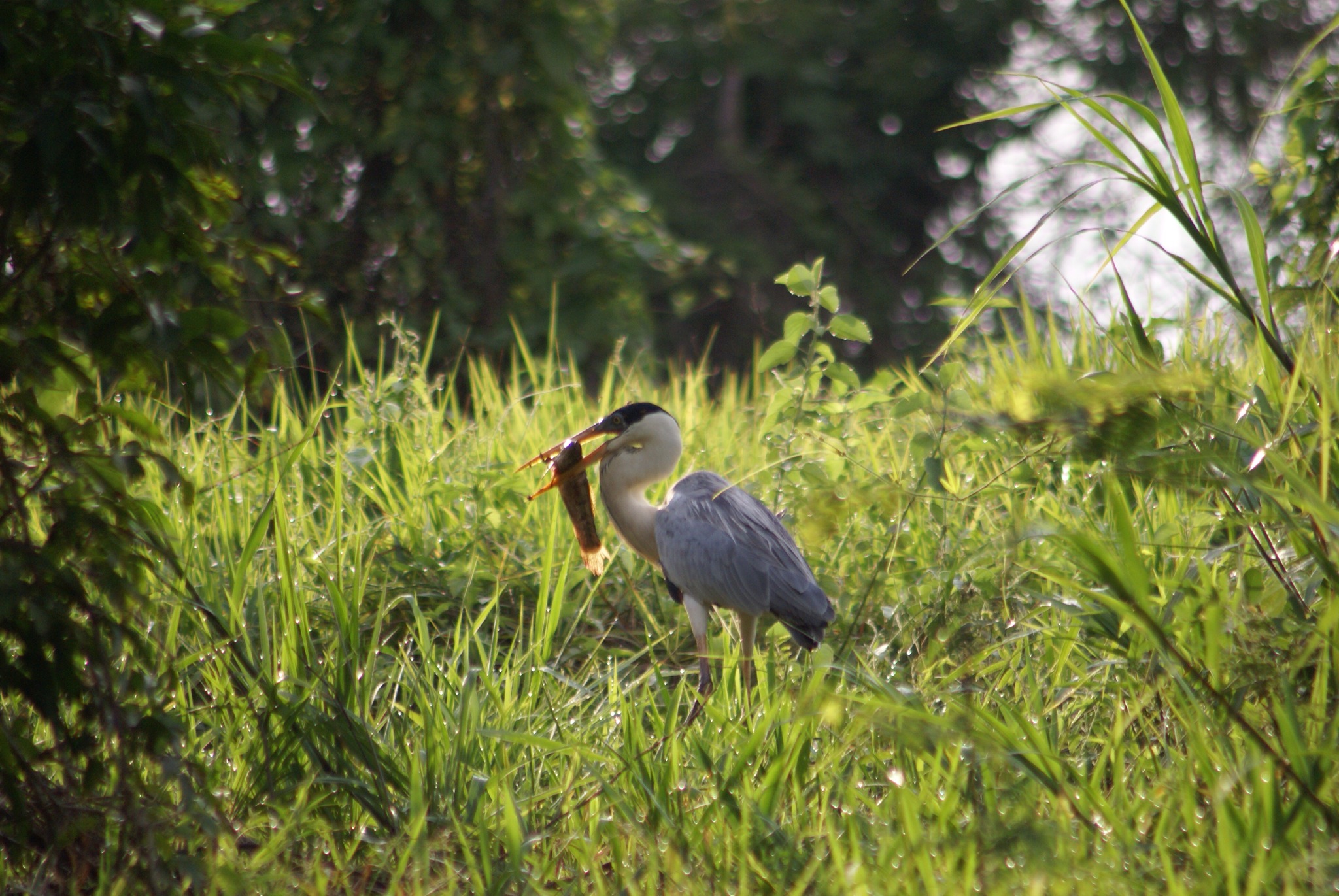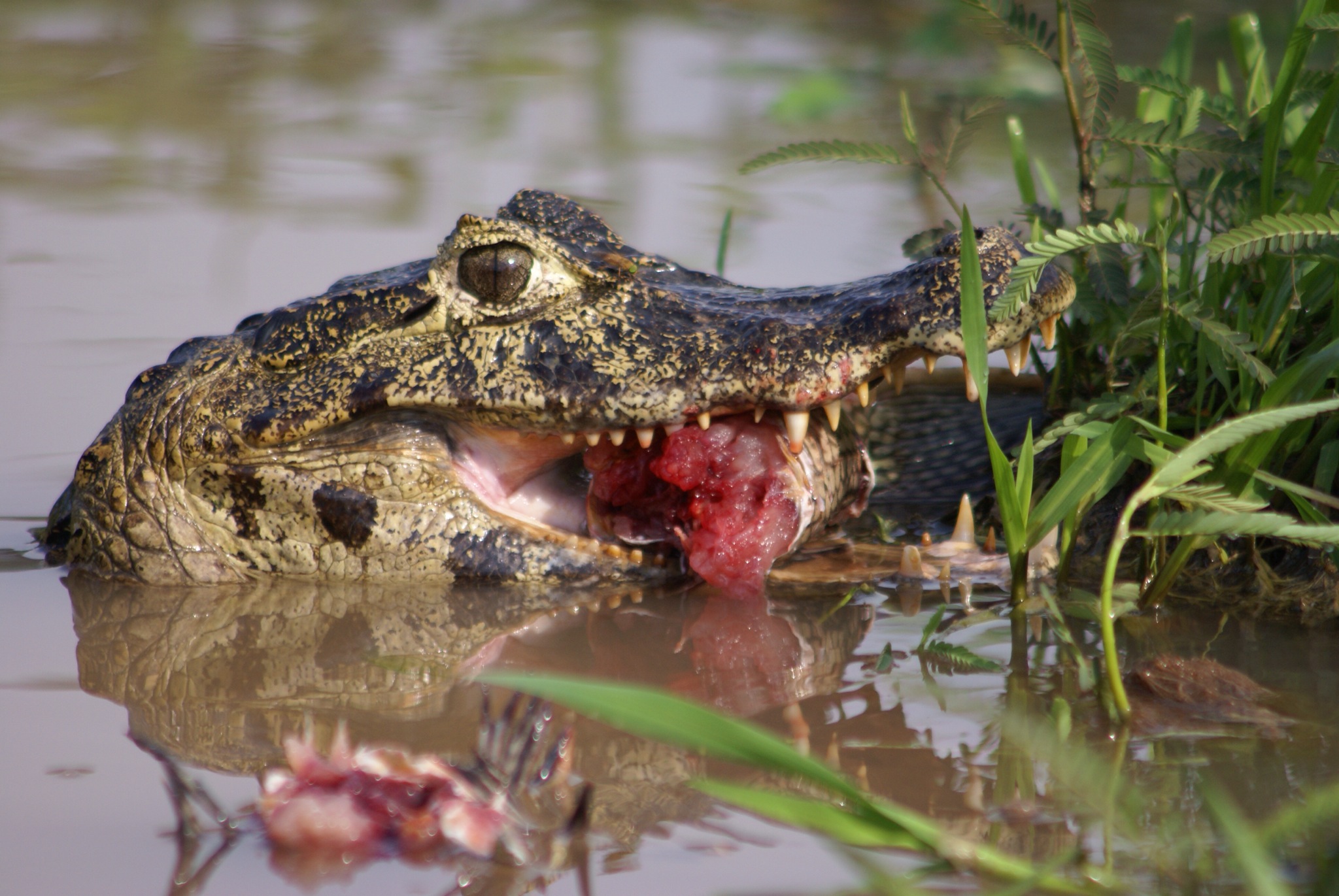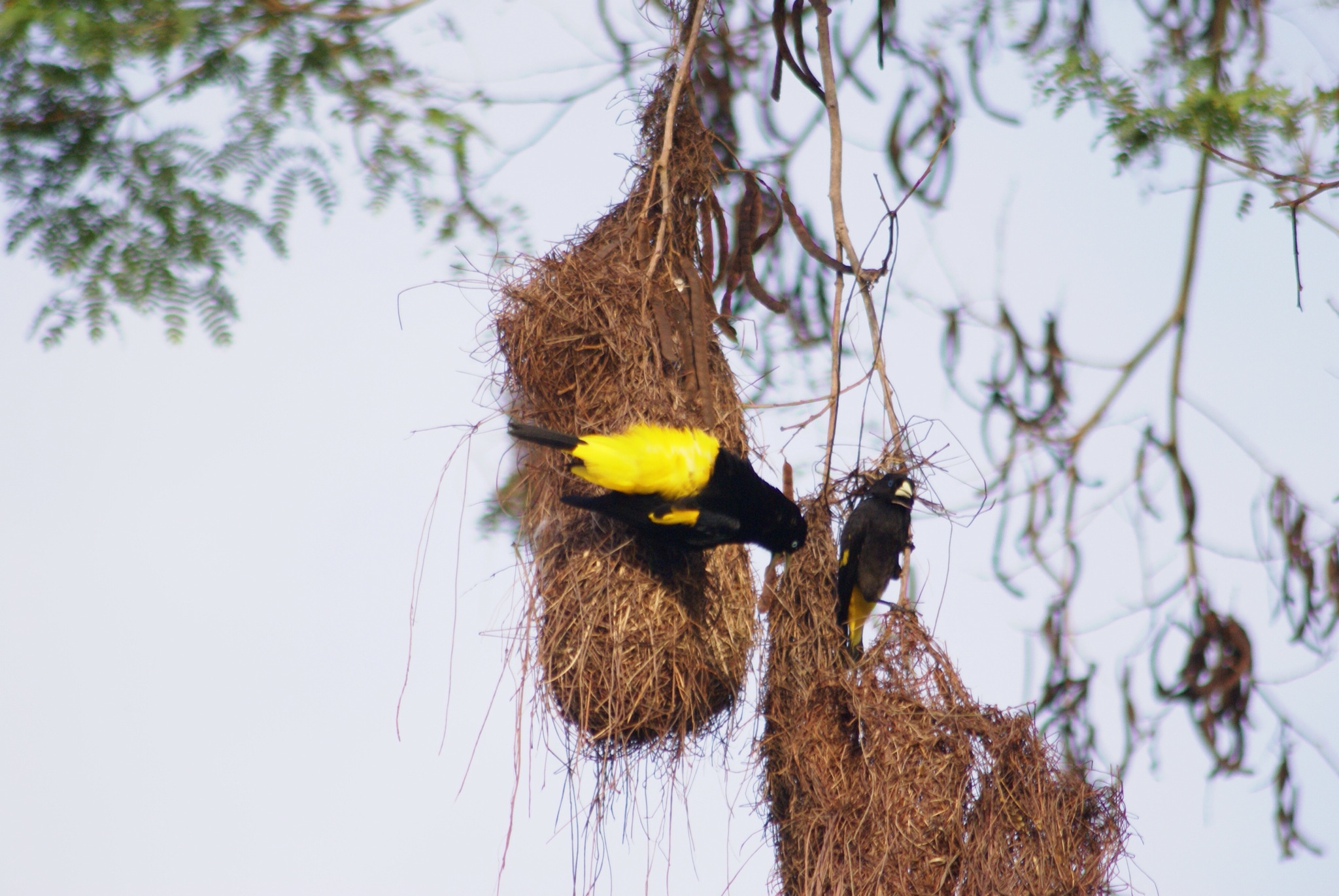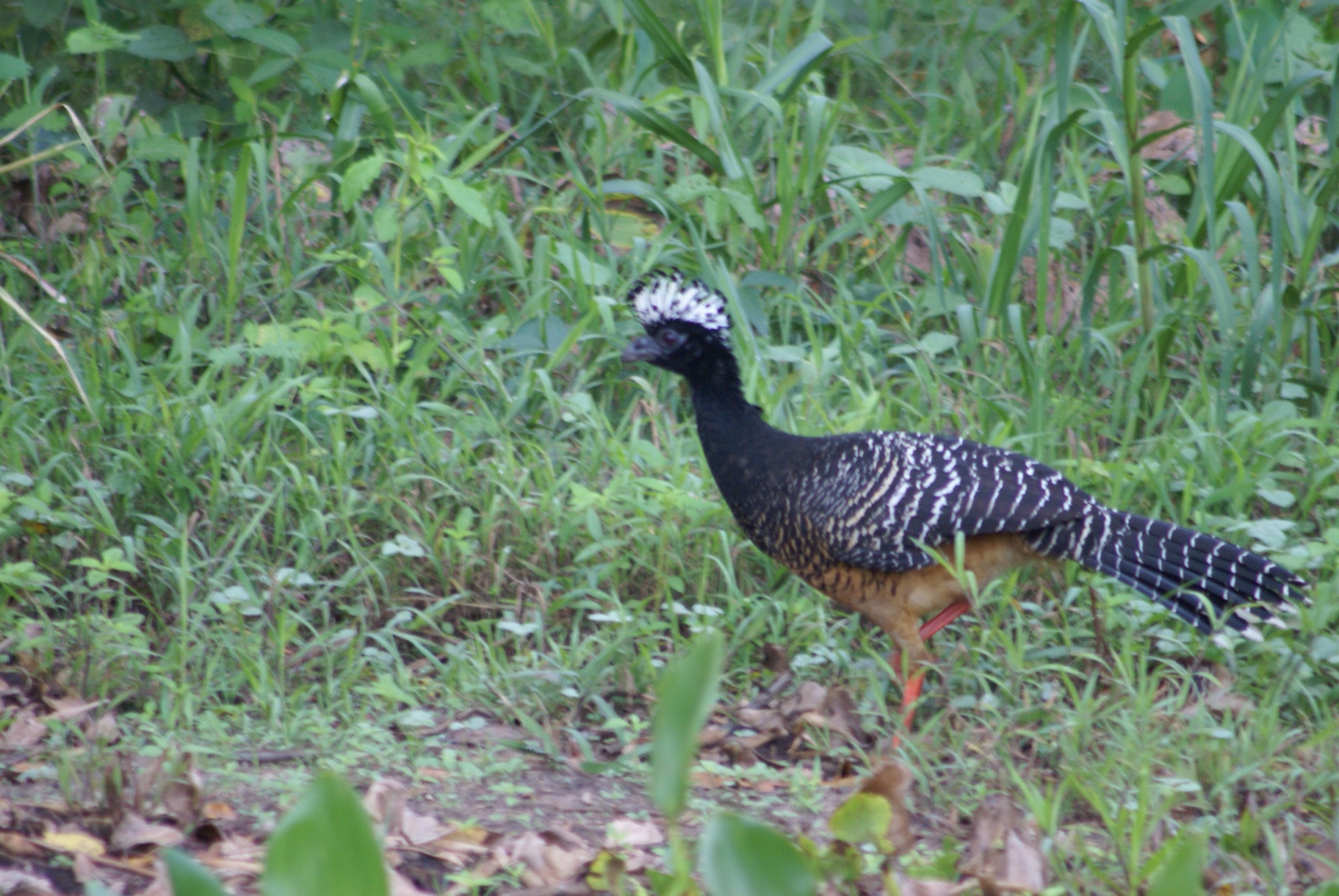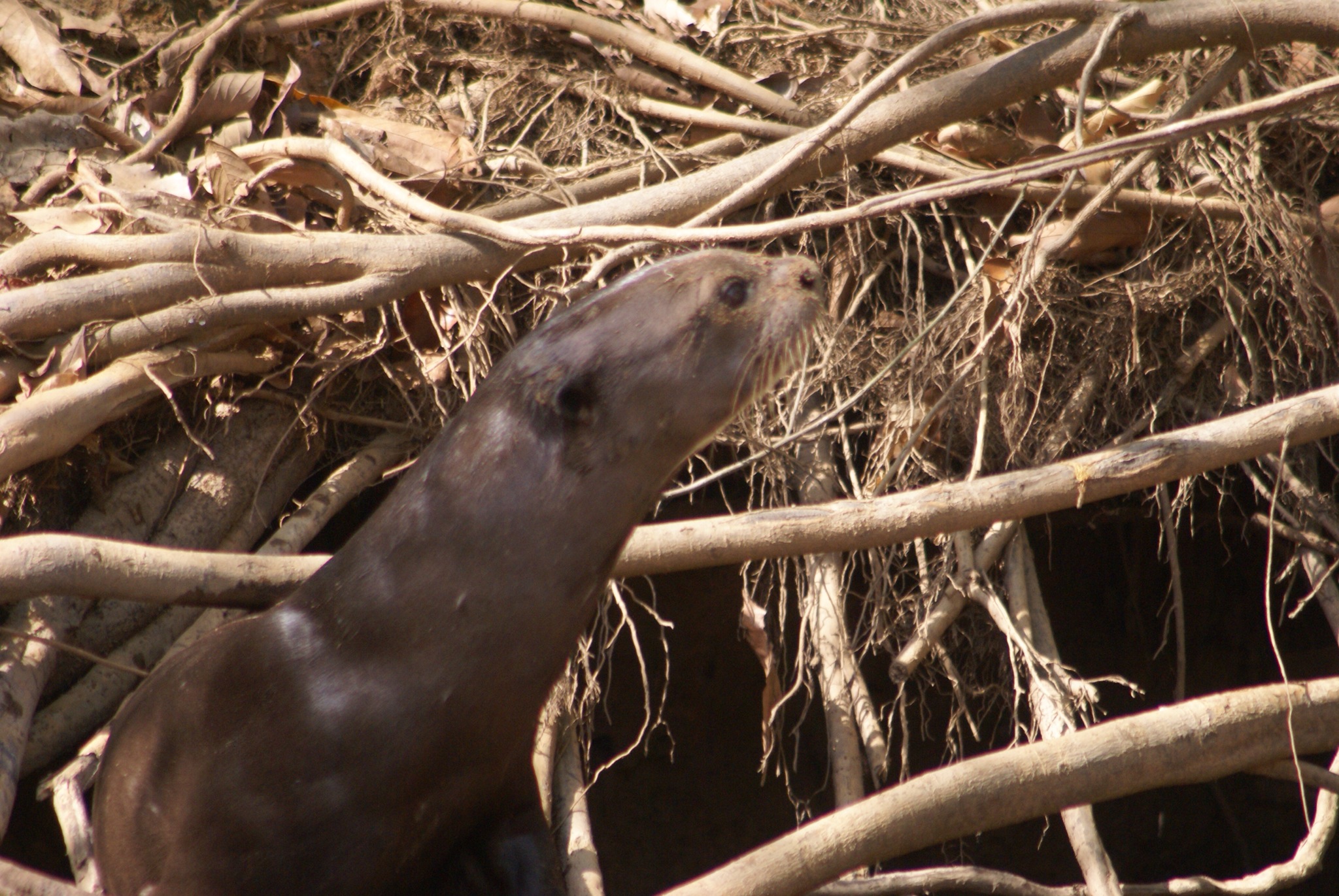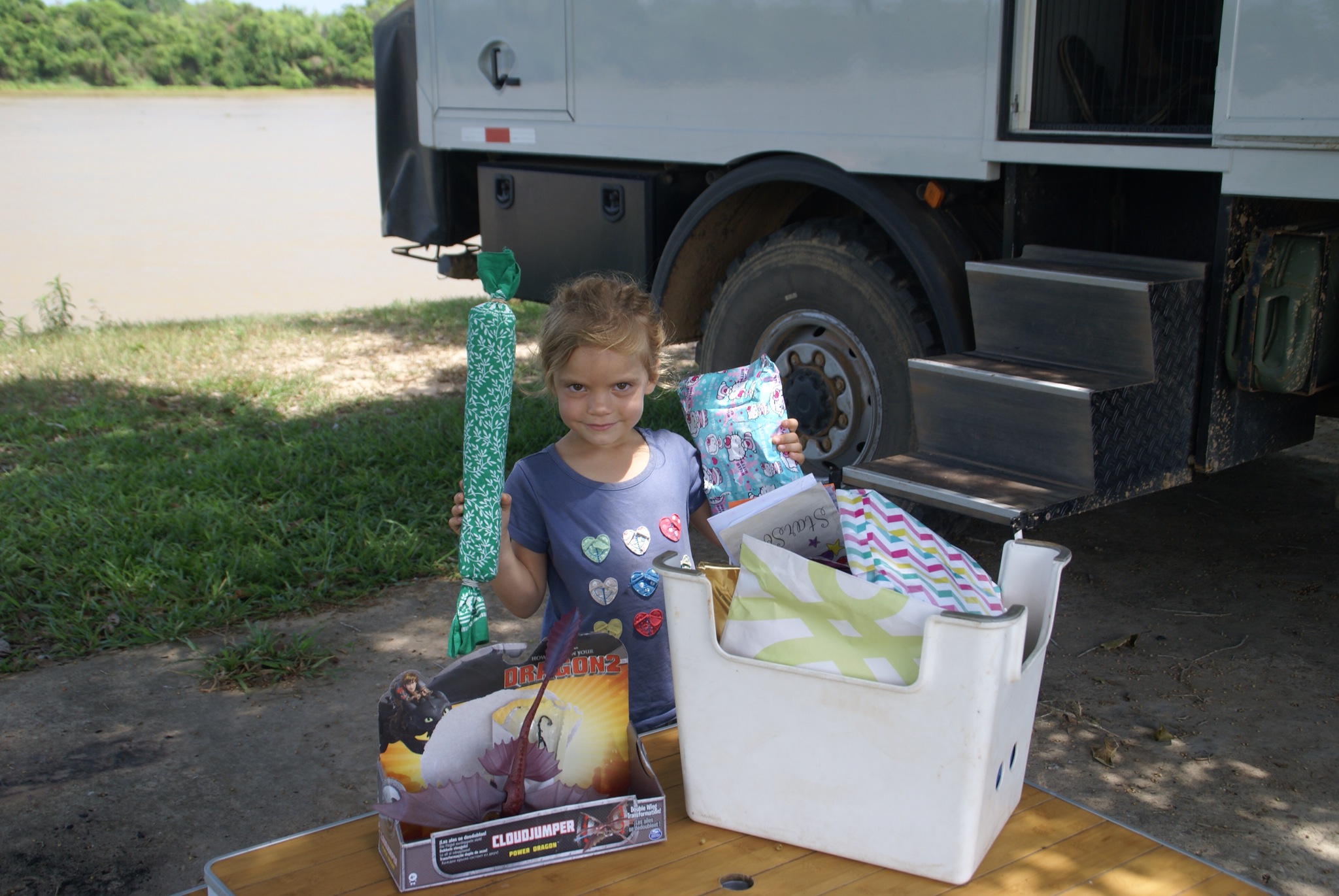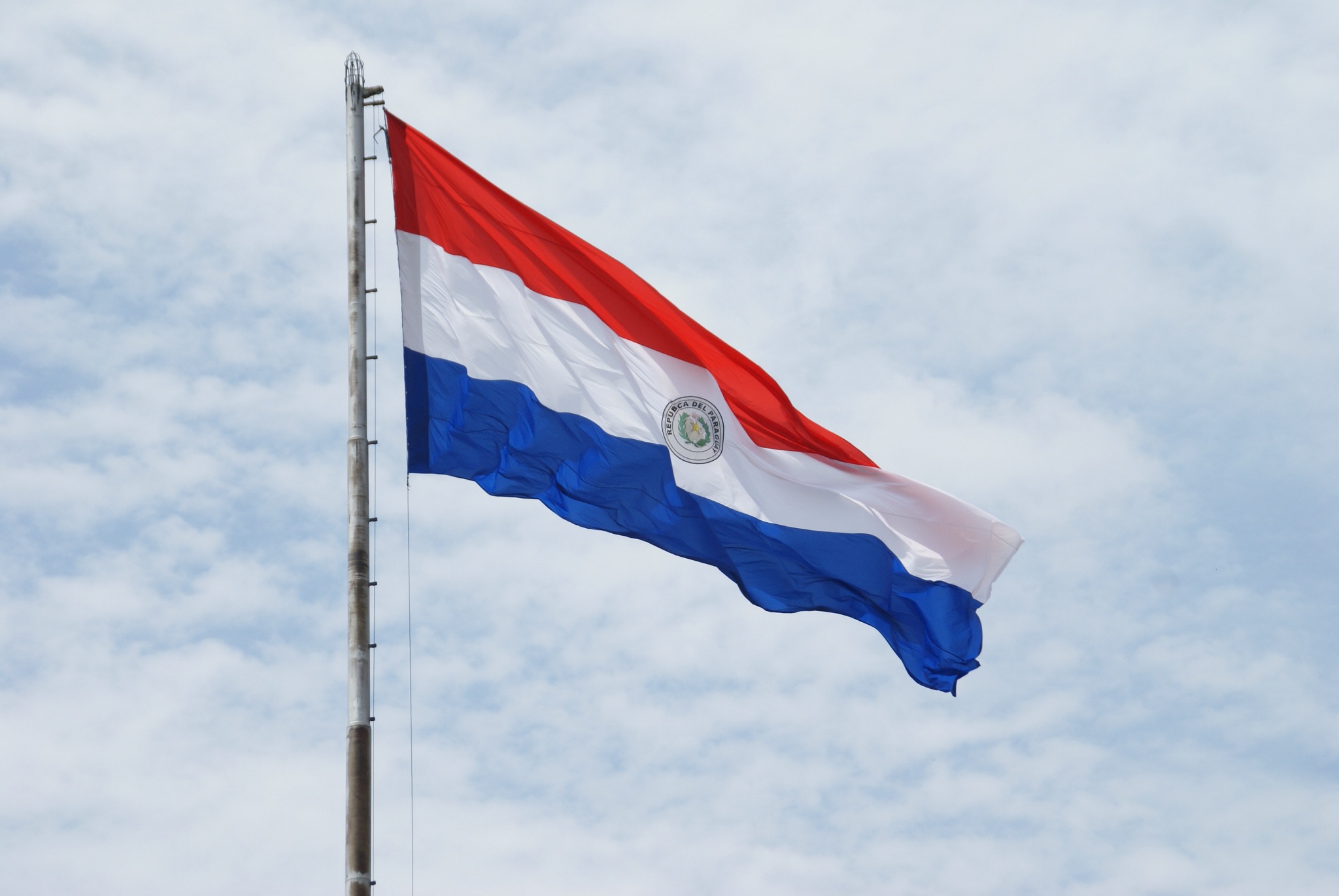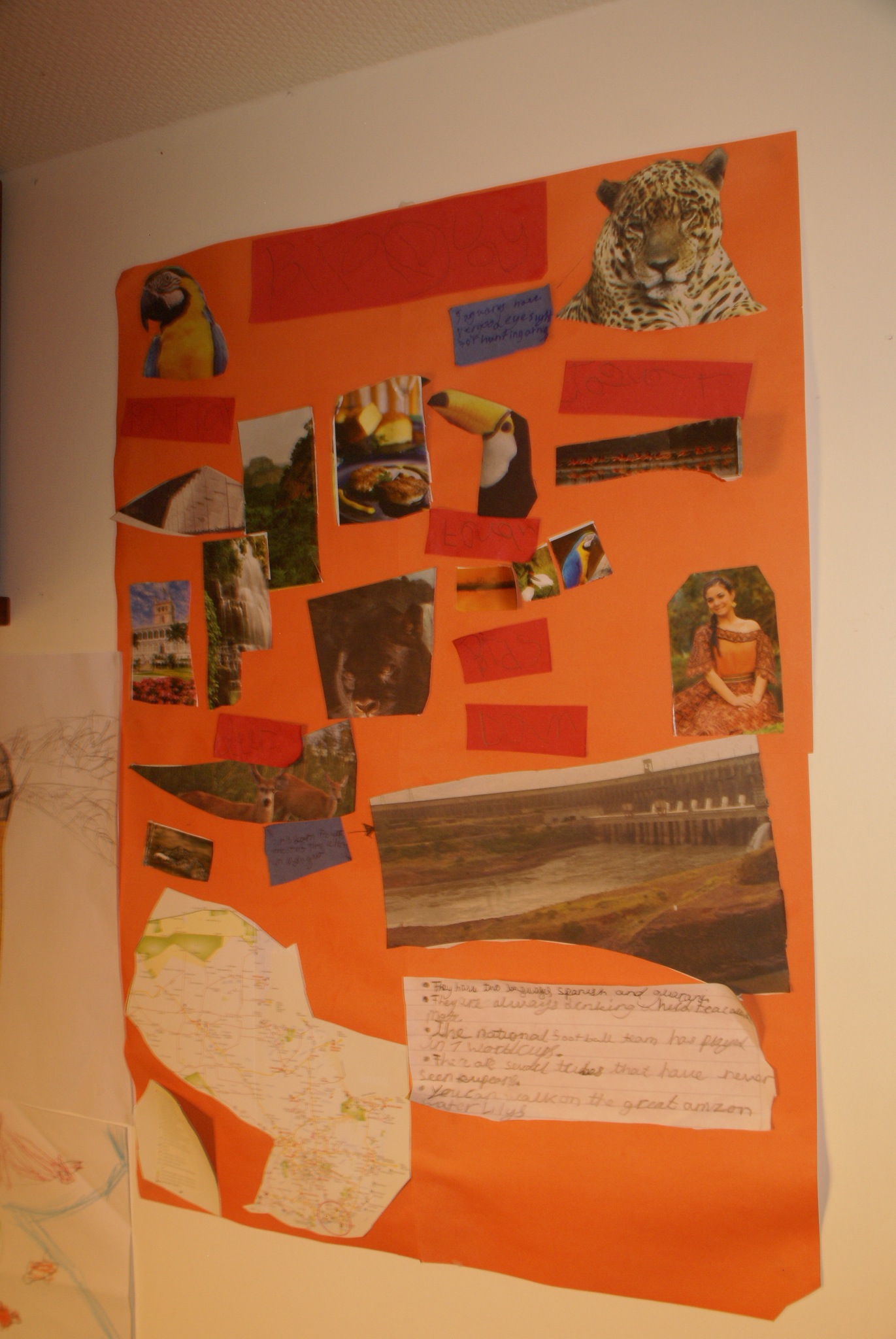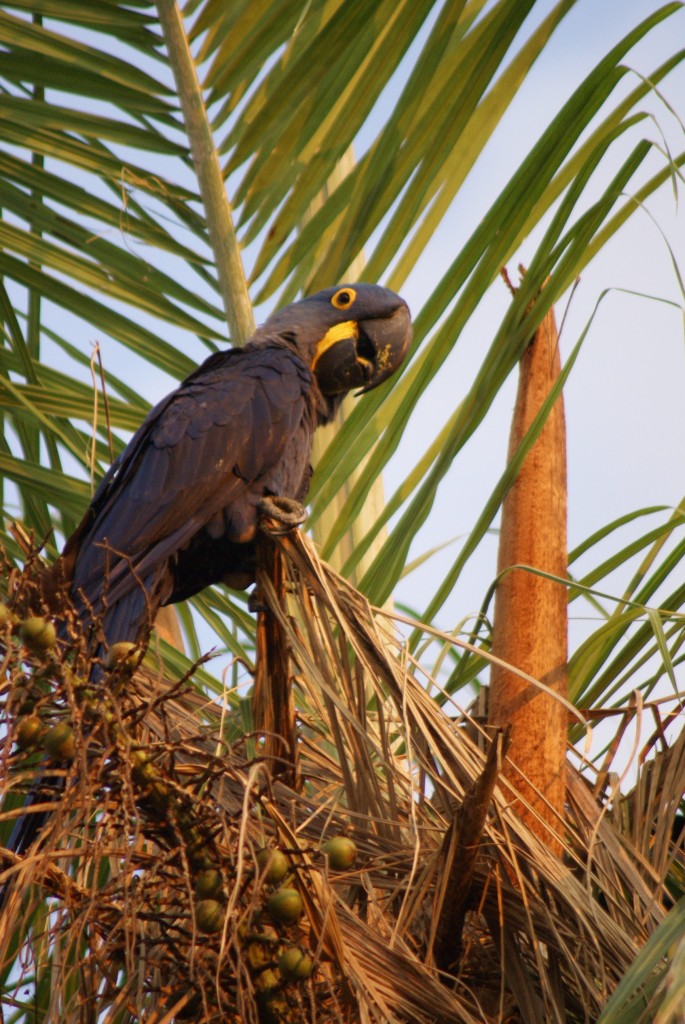
We started our second day in Porto Jofre in the Pantanal, Brazil, keeping our fingers, and toes, crossed that we might have better luck seeing a jaguar on the boat trip. It is one of the best places and best times of the year to get to see these magnificent beasts. Sharing the boat with a couple of lovely European students who are studying here, we motored up and down the river banks and down smaller tributaries looking for the elusive cat. There were lots of easier to spot animals as well: caimens, capybaras, iguanas and lots of birds. After about 5 hours on the water the boat driver got a call over the radio, a jaguar had been spotted. We set off at speed, hoping to get there before it disappeared into the foliage. The driver enjoyed a "James Bond" moment as he powered the boat through the water hyacinth choked waterways. Once we were close though, he slowed right down as he didn't want to disturb it. At last what we'd been looking for all this time. A big male lazing under a tree, its piercing amber eyes taking in the river and everything or everyone on it. I'm pleased we didn't meet him on foot, when he yawned we got a good look at his killer canines. He looked Iike he'd had a good night hunting with a full belly and now his main priority was trying to keep cool in the relentless heat. We watched him for a couple of hours while he lazed under a tree, always keeping half an eye open. We could see how his spotted rosettes would hide him in the dappled shade but being right on the edge of the bank must have given him a slight breeze.
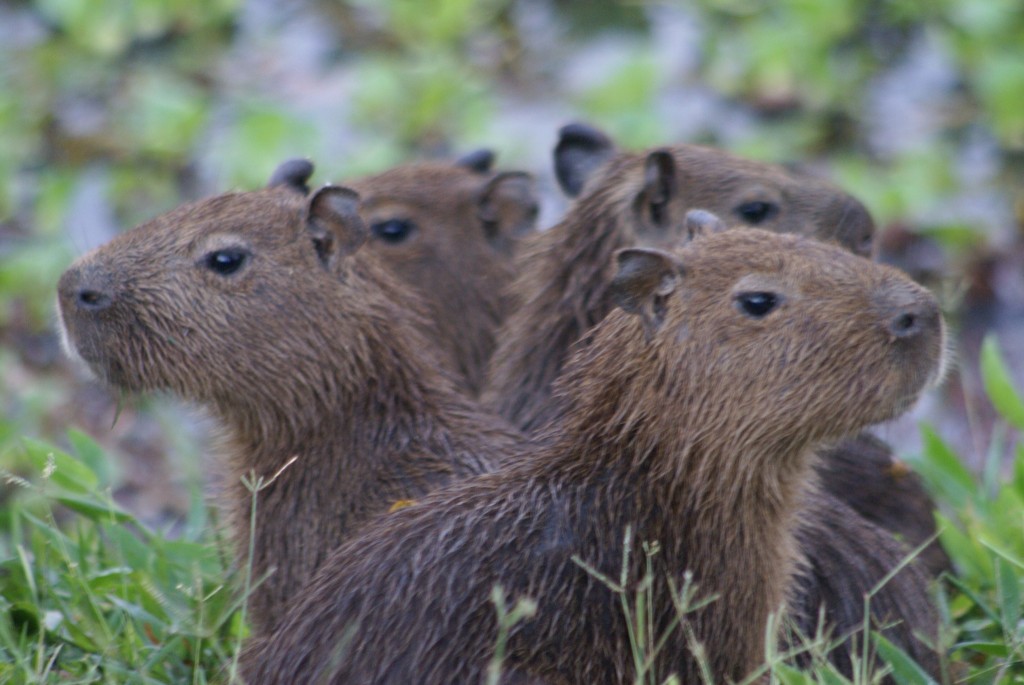
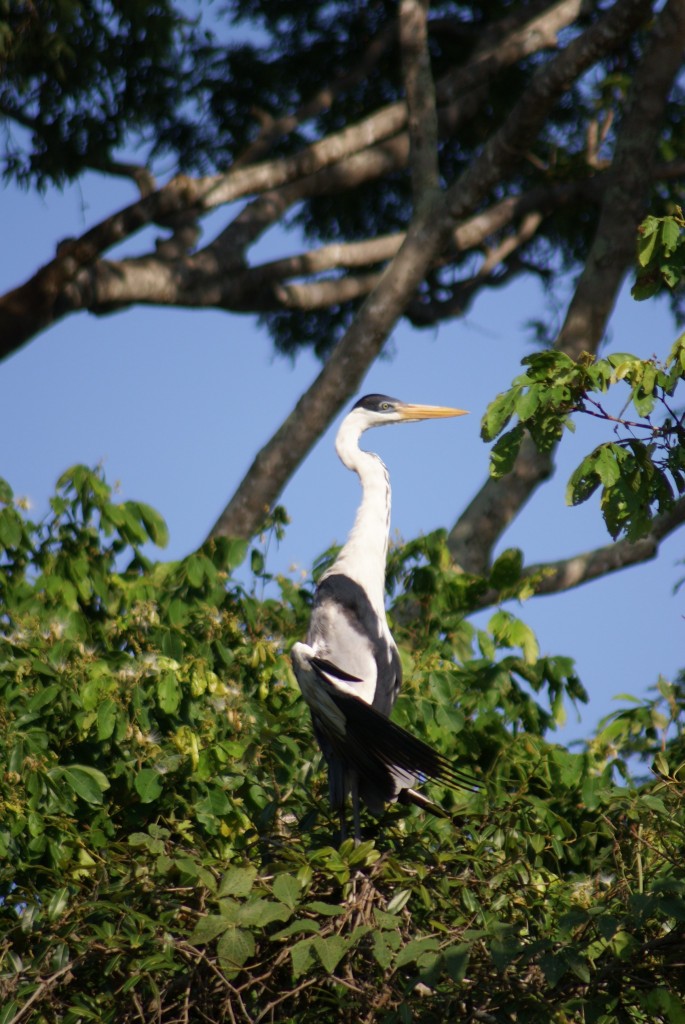
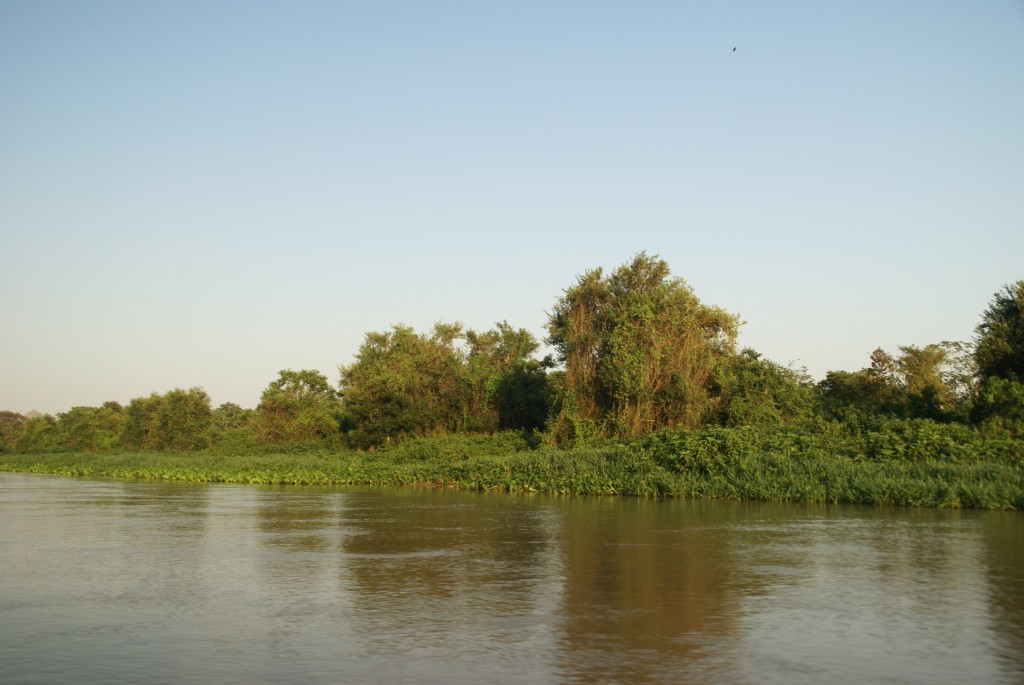
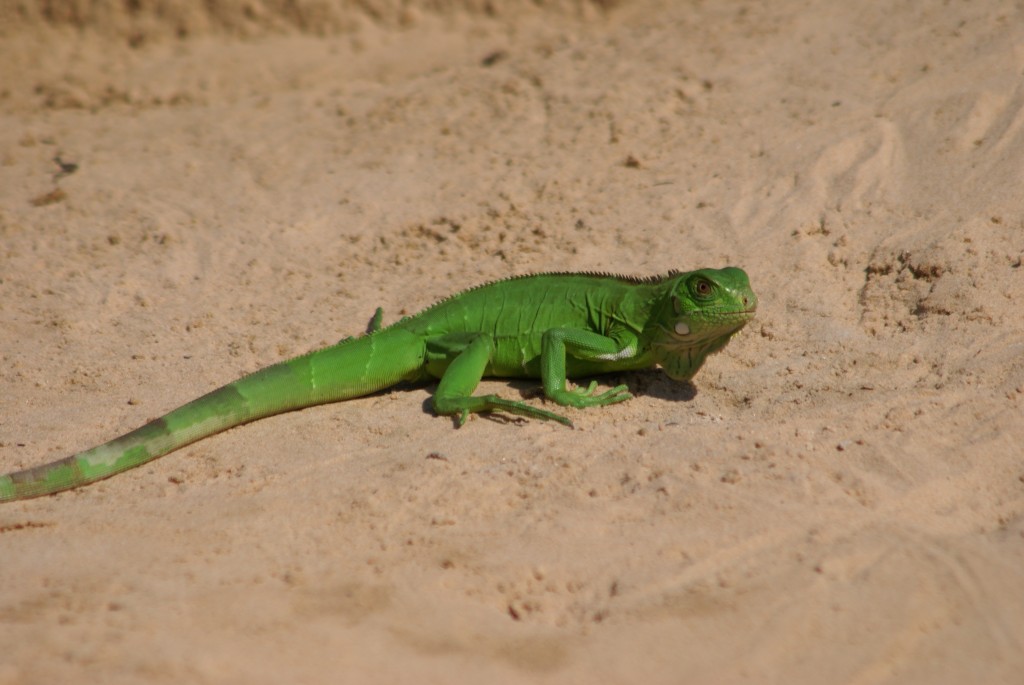
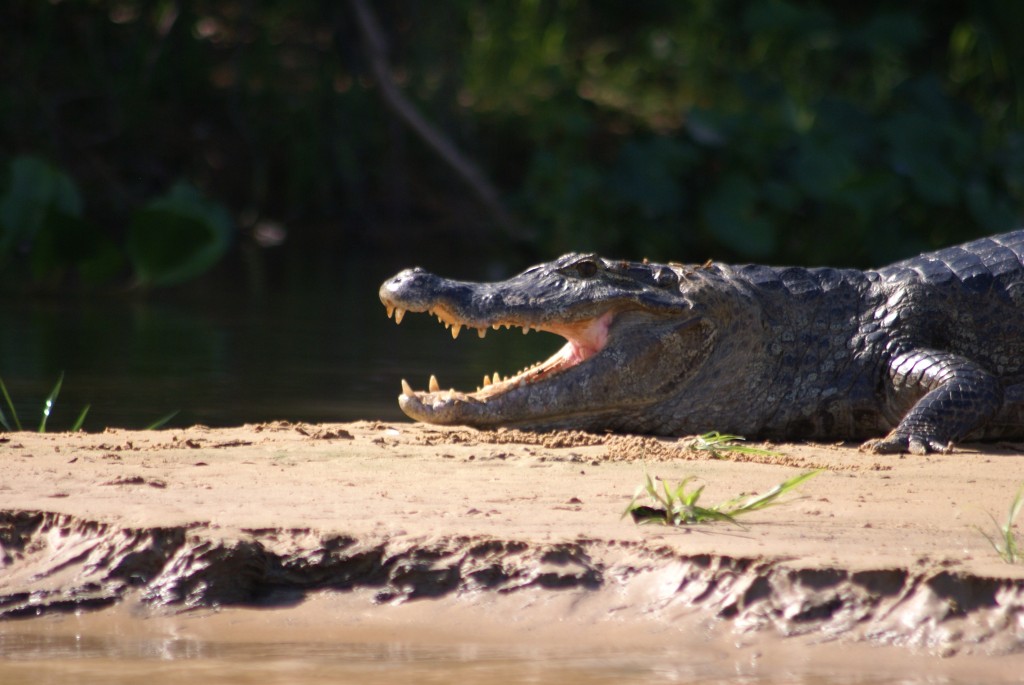
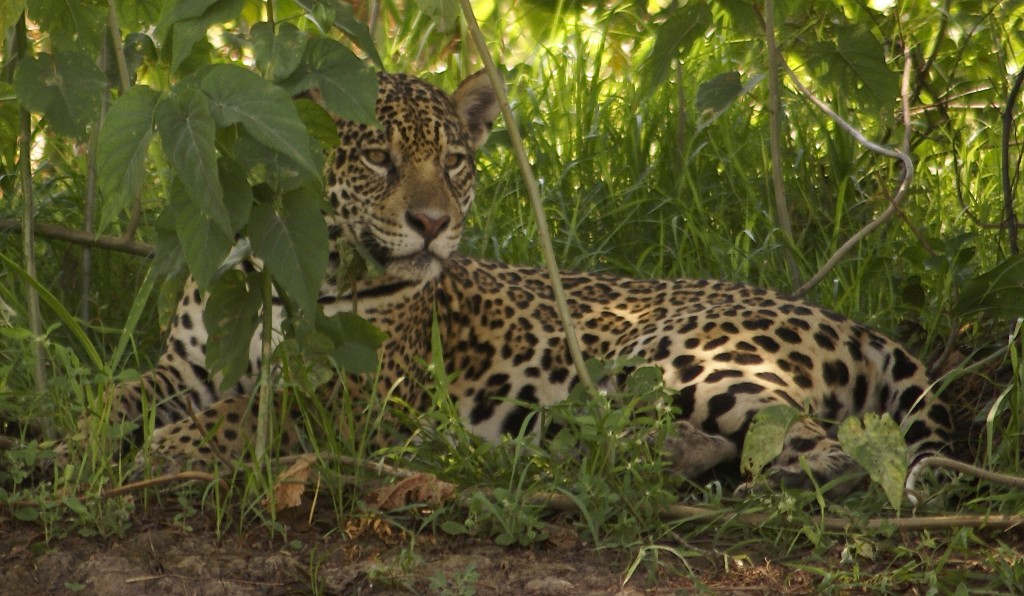
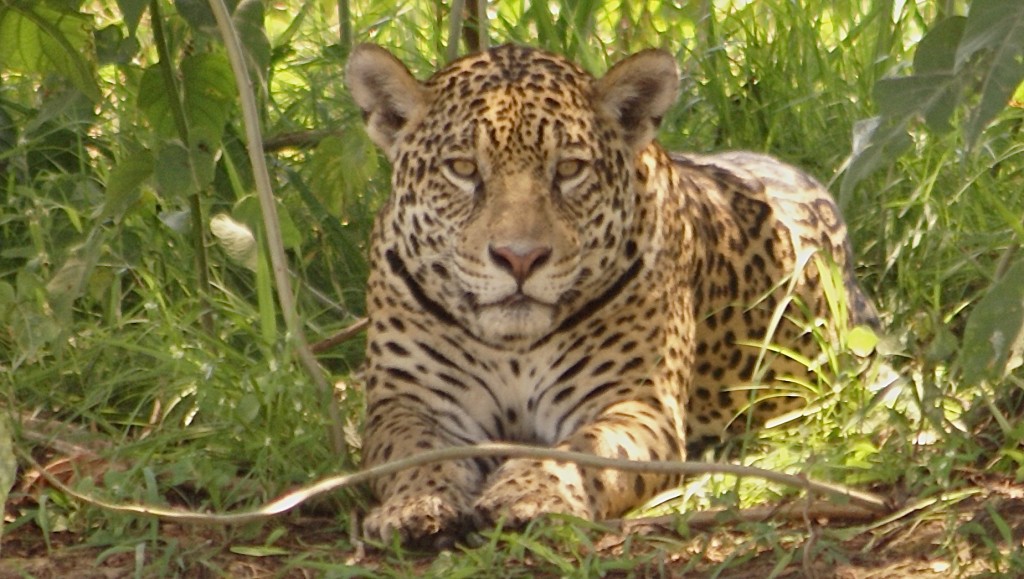
We returned happy to our beautiful spot by the river, where we were camping for free in the Hotel Porto Jofre grounds. One of the positive things about 40°C heat was that our massive load of handwashing dried in about half an hour. After our jobs we cooled off in their lovely pool.
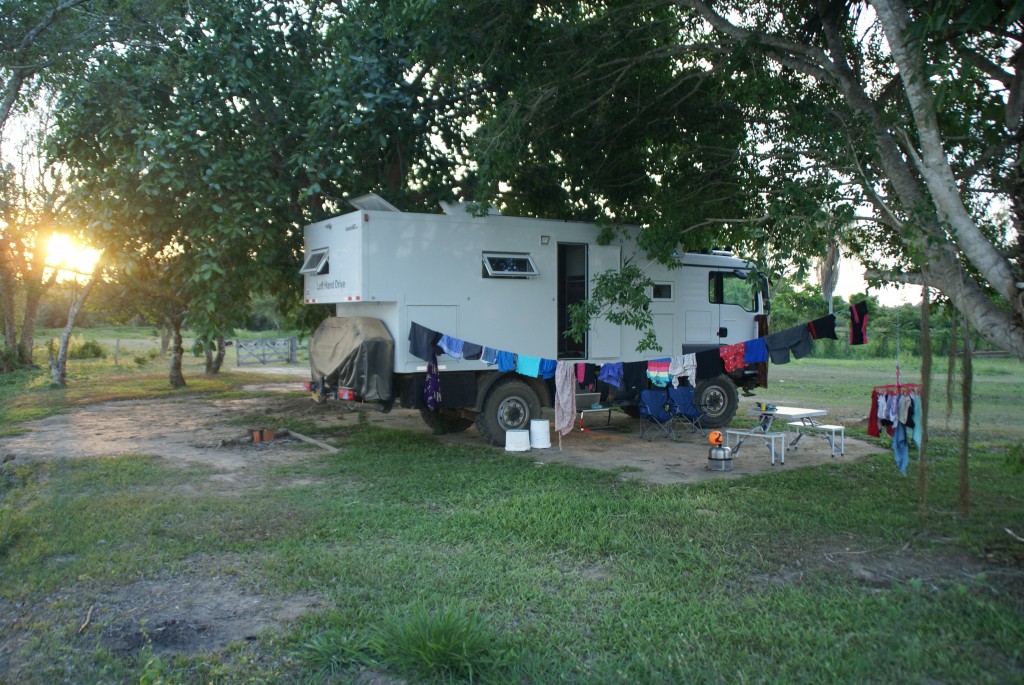
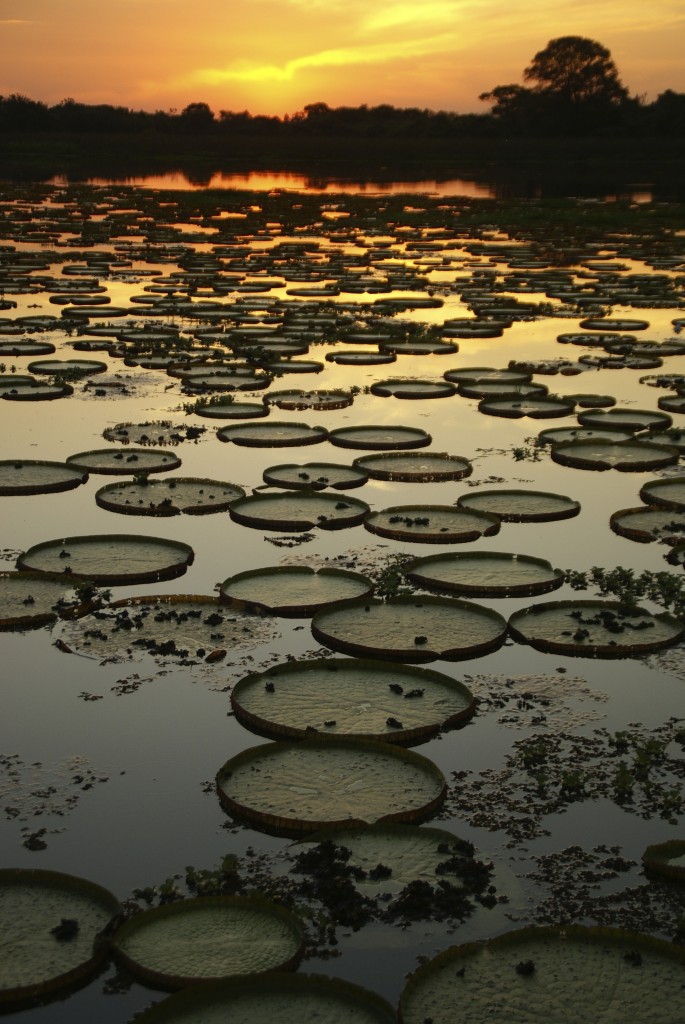
The 5am starts, as well at the baking heat, was starting to wear everyone and their tempers, so we decided to have a more relaxing day. The girls laid in, while I went out in the grounds for sunrise. The amount of birds was astounding, although not a true bird watcher, I couldn't quite decide what to walk over to first: the hyacinth macaws in the palm trees, the jabiru storks by the pond or the yellow weaver birds building their nests by the river.
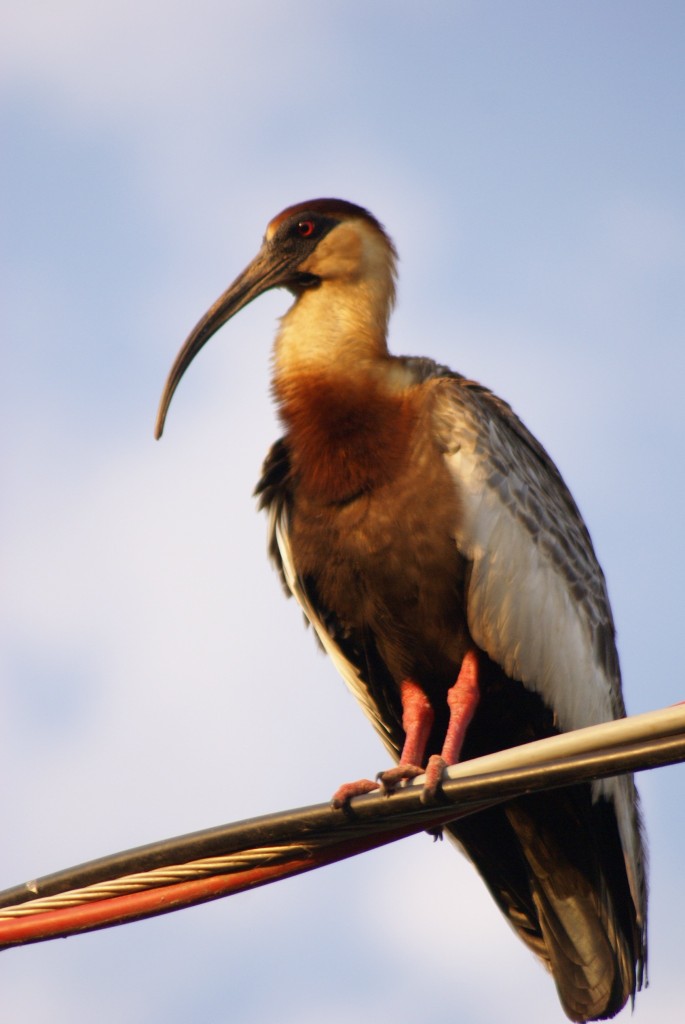
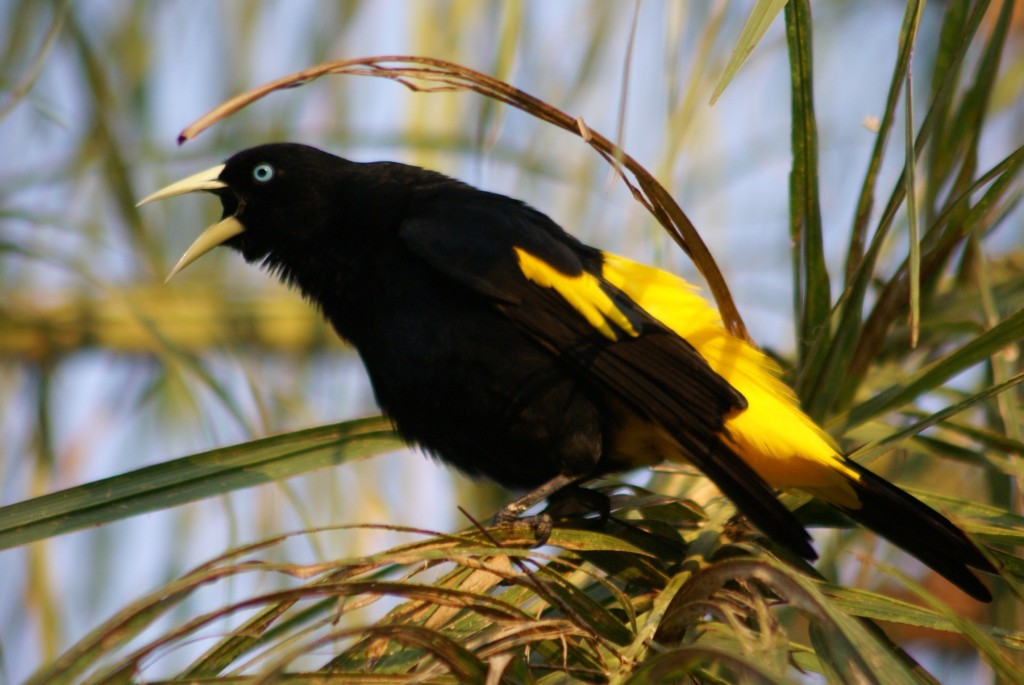
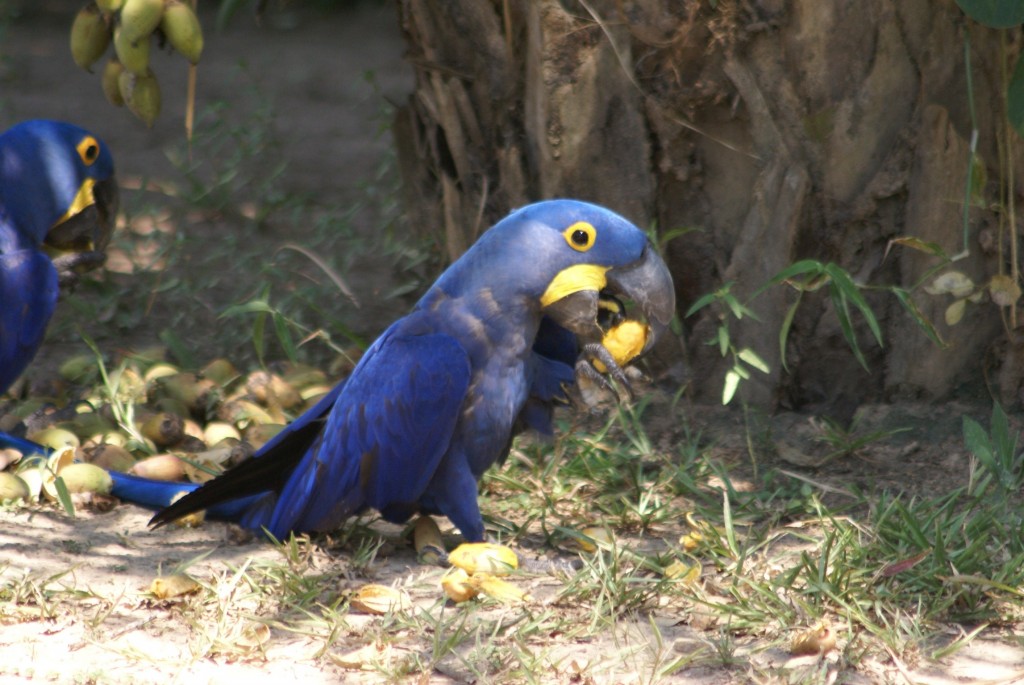
That evening we took another drive out along the road, we had no luck with the animals but watching the sun go down over the marshlands was magical. That evening we escaped the heat and ferocious mosquitoes by eating in the hotel's restaurant. We've had to abandon cooking anything in the truck as it takes the temperature inside from oven to furnace, so we are using the Cobb barbecue outside for everything.
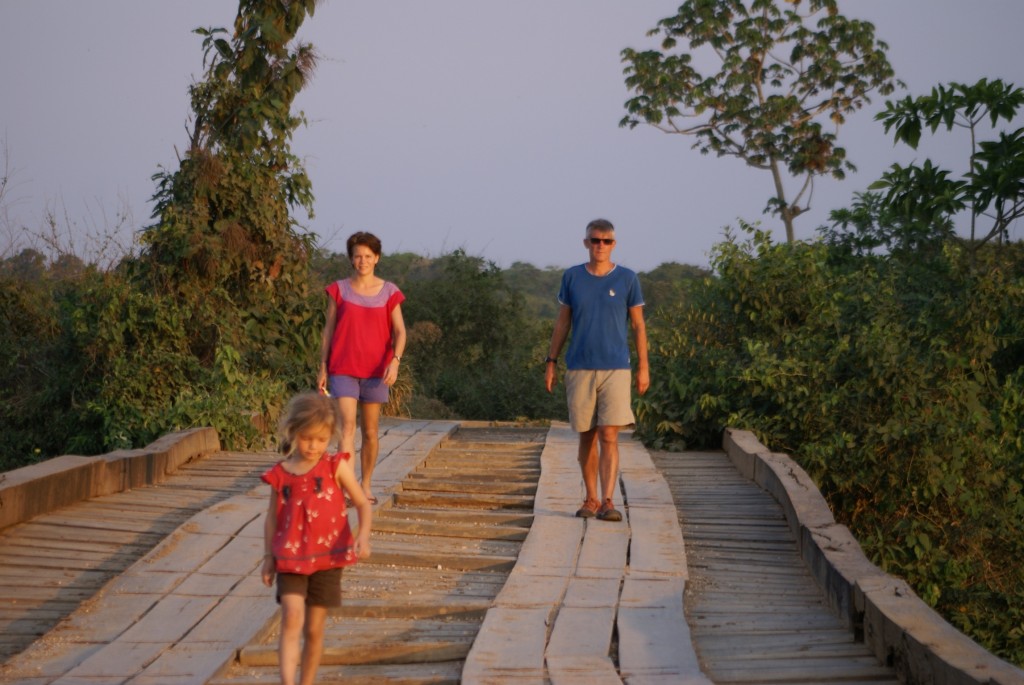
After another 5am start the following day for a 7 hour trip on the river, we were rewarded early on with a family of about 10 giant river otters. There were about 6 juveniles who were in a very playful mood. After watching them hunt and hearing them noisily crunch through the fish they had caught, we watched them play. We had stopped next to a small floating island of reeds a respectful distance away, but we were so lucky as they came to wrestle with each other on the island right next to us. Like children everywhere they tussled, snuck up on each other and tumbled around. It was hard to tell which otter was which as they became a tumbling mass of sleek, brown, furry bodies.
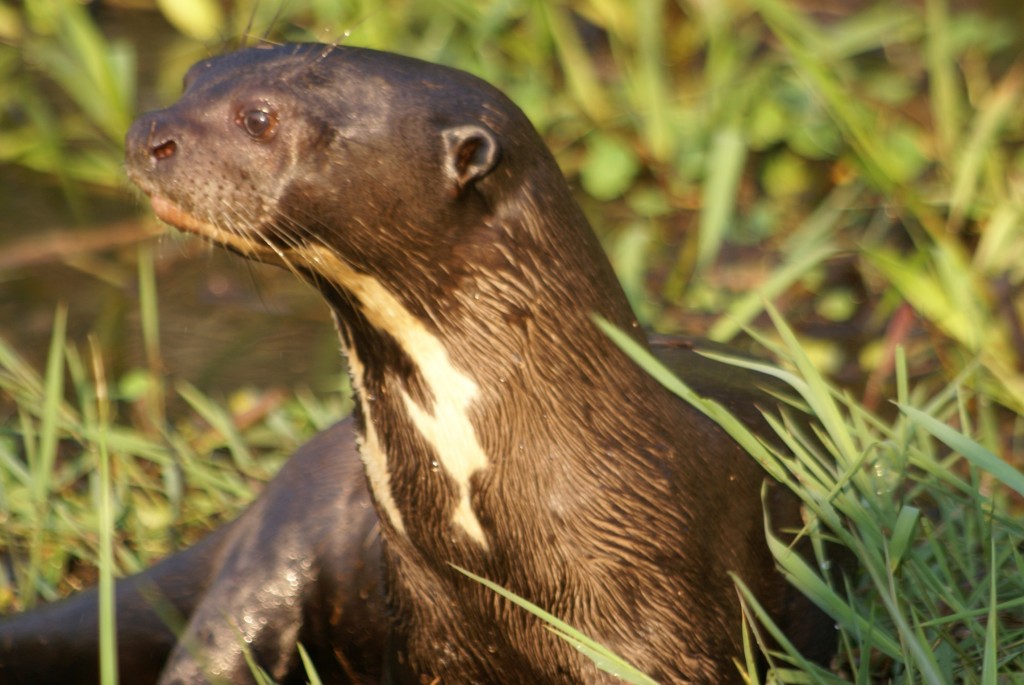
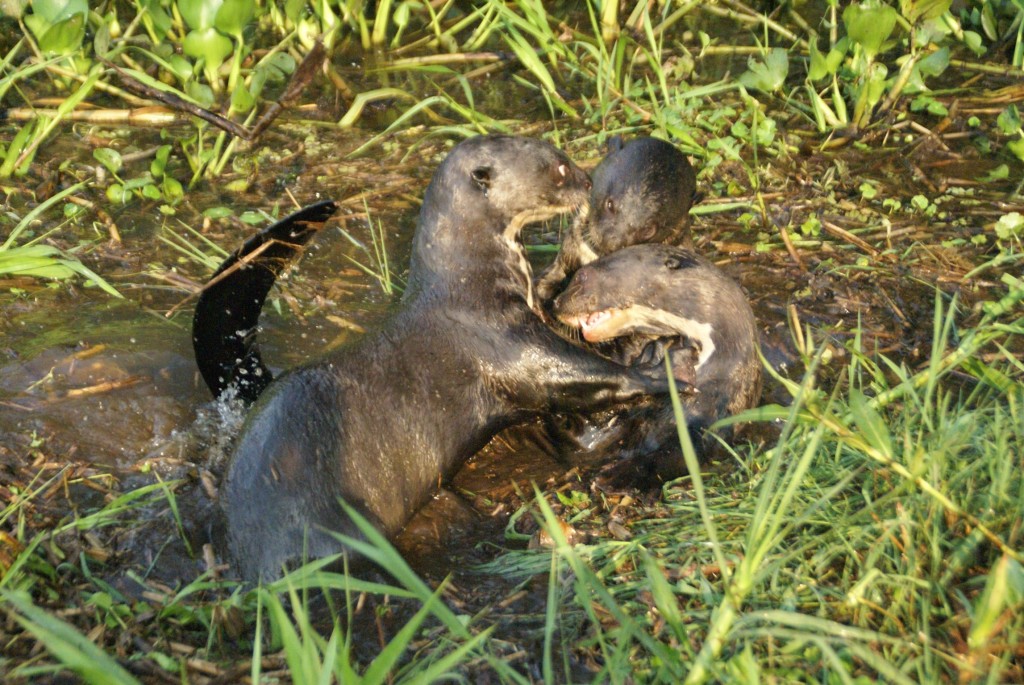
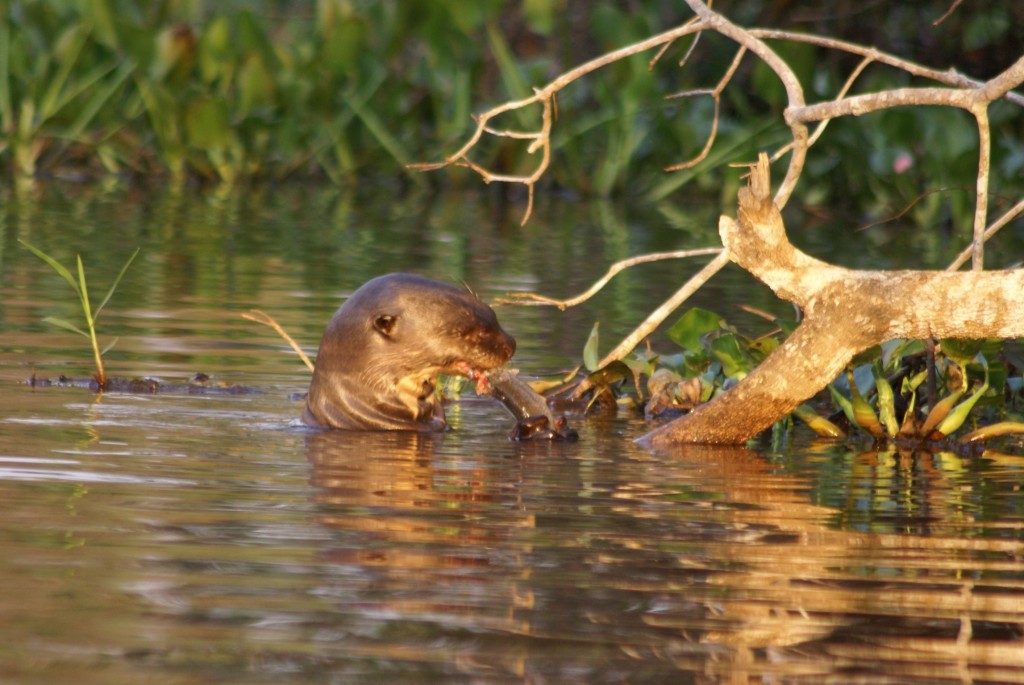
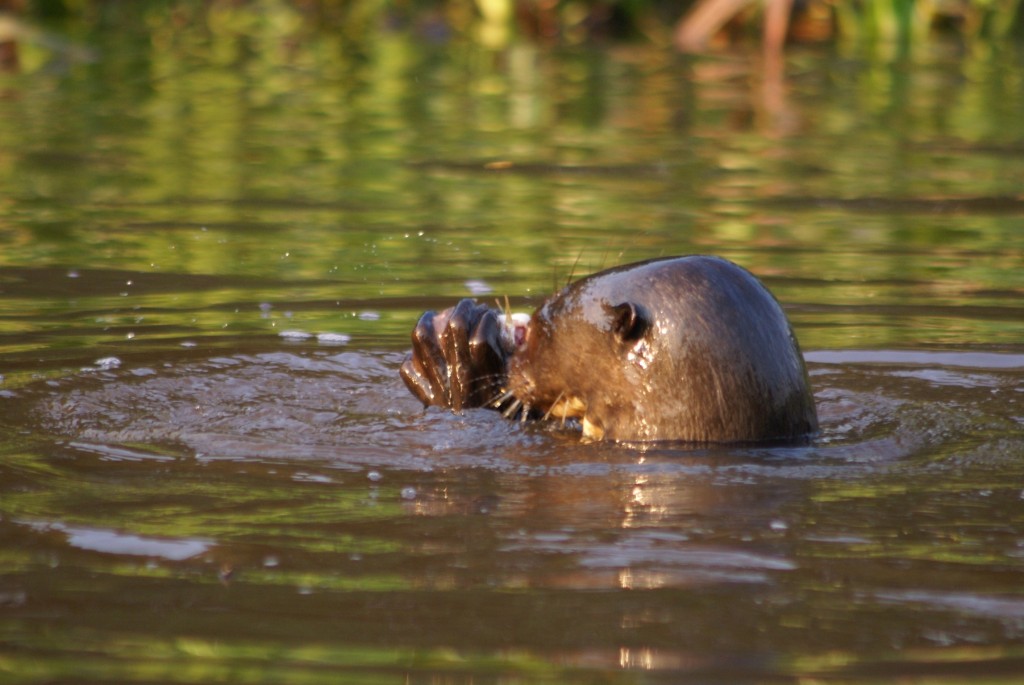
After the otters had swam off, we were off again searching for jaguars. We were so lucky and managed to see three during the morning. The first was another big male, he sauntered along the riverbank looking every inch the top carnivore he is. However he soon settled down for a deep sleep under a bush almost disappearing from view in the deep shade. The second we found looking out over the river but soon moved off into the deep bush. Jaguars here sleep on the banks of the river during the day as it is a little cooler, which is why they are easier to see here than many places. Our third siting was amazing. We saw the long grass on the riverbank sway and ripple way before we saw what was causing it. We figured it had to be something big and powerful with the way the grass was moving. We were absolutely right it was a big strapping male, well fed and in his prime. He was moving with purpose at the edge of the river, through the long grass. When it got too steep he plunged into the muddy brown waters. He paddled his way along the shoreline. I knew jaguars could swim but didn't realise they were as agile in the water as they are on land. Striding in and out of the water, he was obviously looking for something. We followed him for about half an hour as he moved upstream hunting for caimans. Twice there was a huge splash from the grassy edge as panicking caimans launched themselves into the water, just in time to escape from the jaguar's jaws. We knew this must be something very special when our boat driver started taking a video on his mobile phone. Disappearing again into the long grass, the vegetation quivered and oscillated as the huge head and powerful shoulders parted through it. Suddenly there was an almighty splash and frantic crashing from the grass, silence, then some more thrashes and the sound of a final writhing. Standing on our tiptoes we could see the stilled back of a big caiman and the panting jaguar. Our last view of the magnificent beast was the rather undignified view of his backside as he was humping his overweight pray away from the river's edge. We couldn't believe how lucky we had been to see this so rare and elusive animal in its natural environment, hunting. We kept on recounting parts of what we'd seen to each other all day, not quite believing what we'd witnessed.
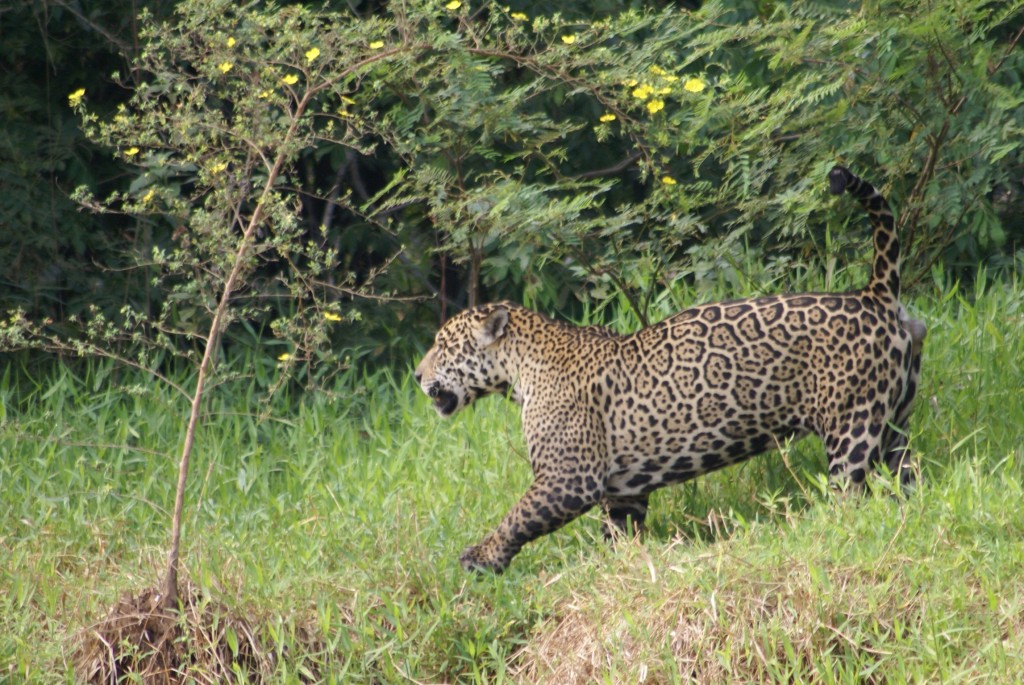
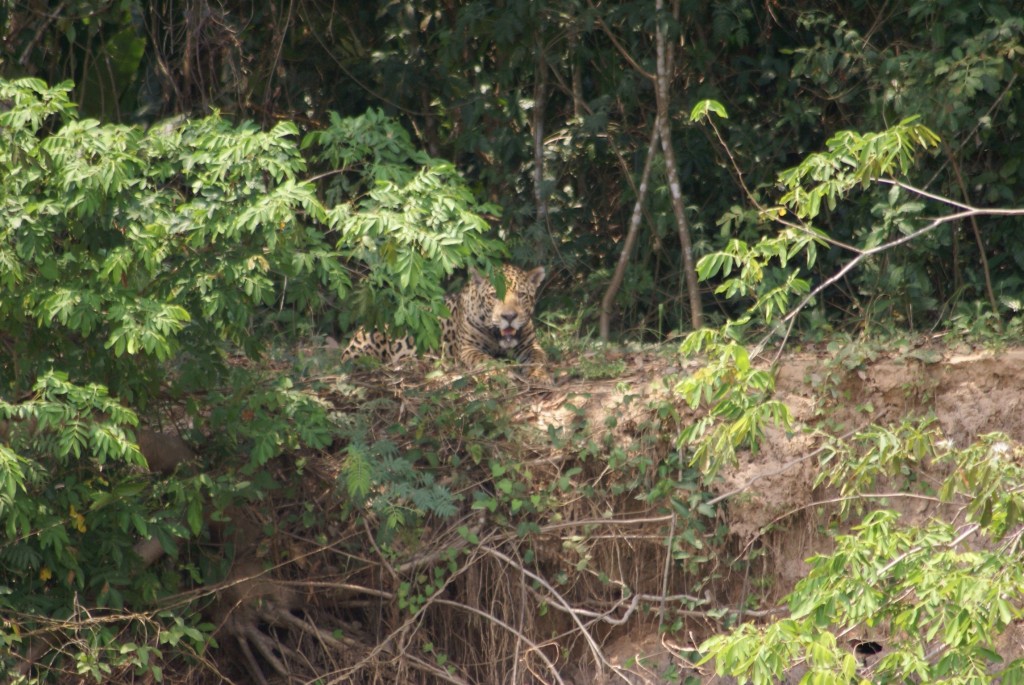
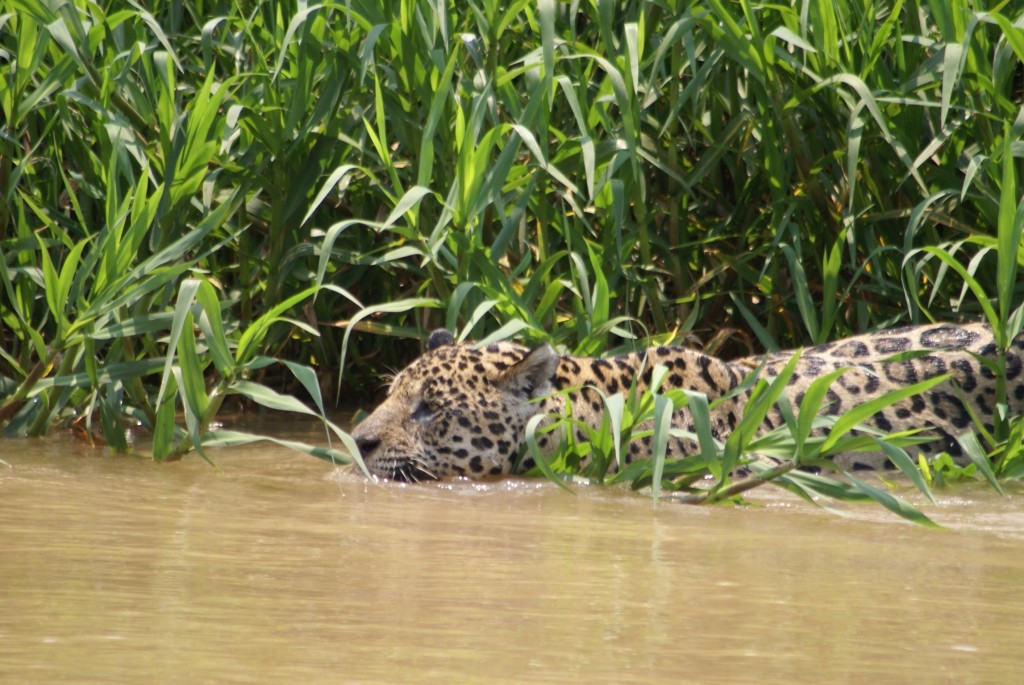
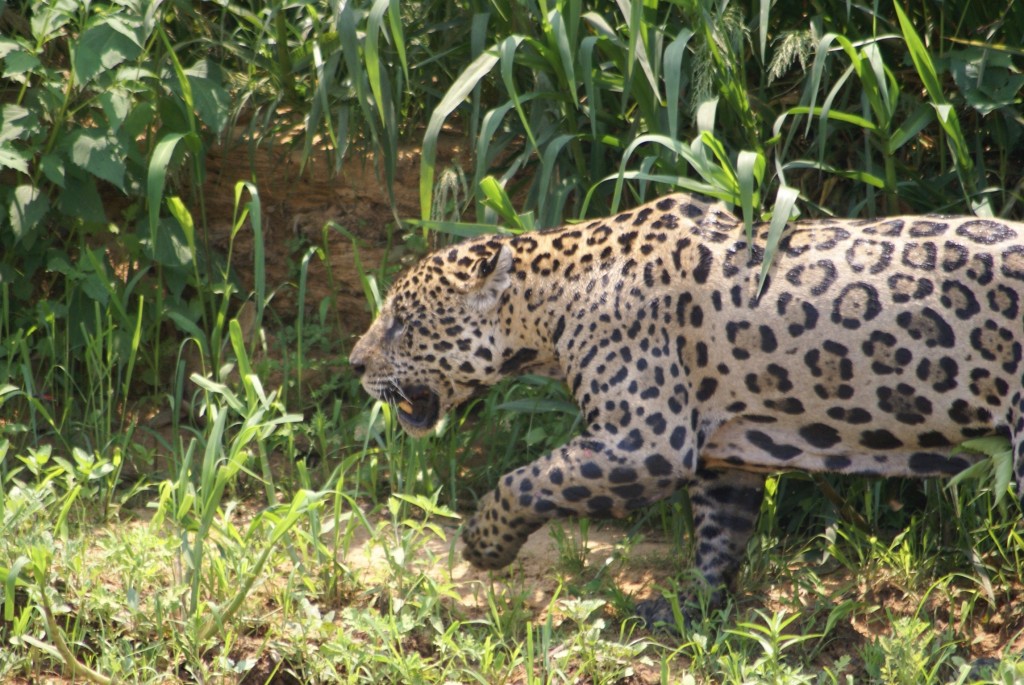
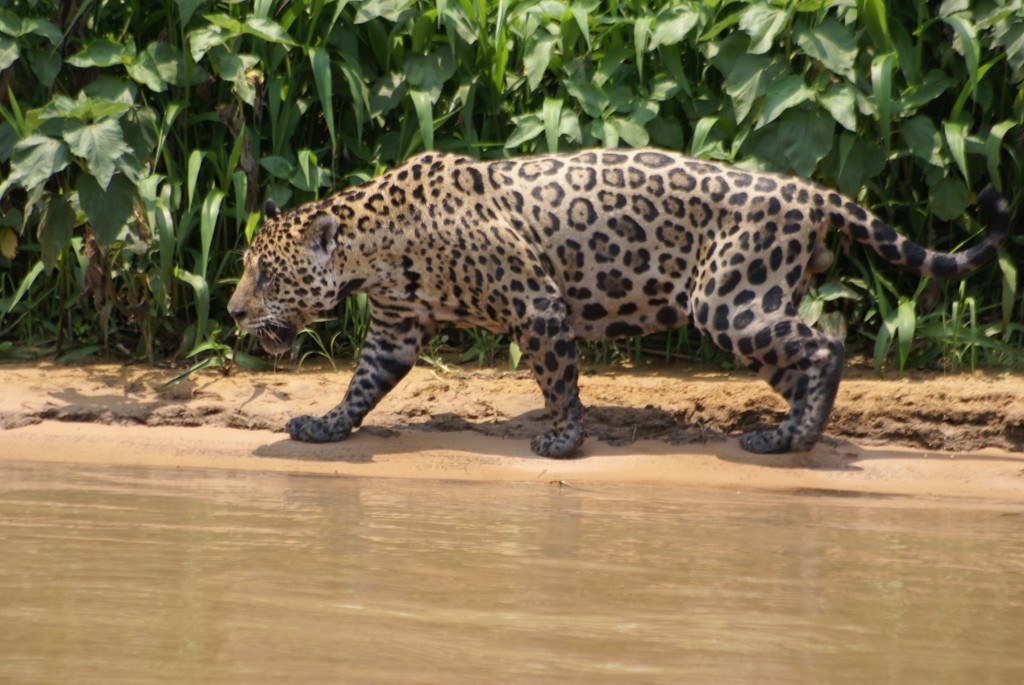
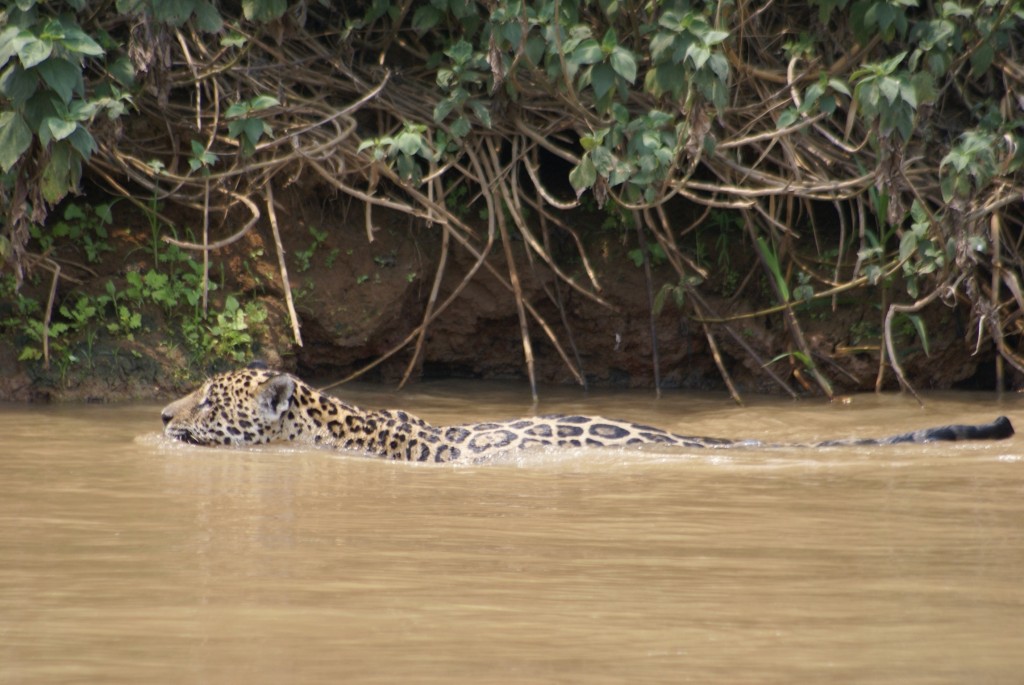
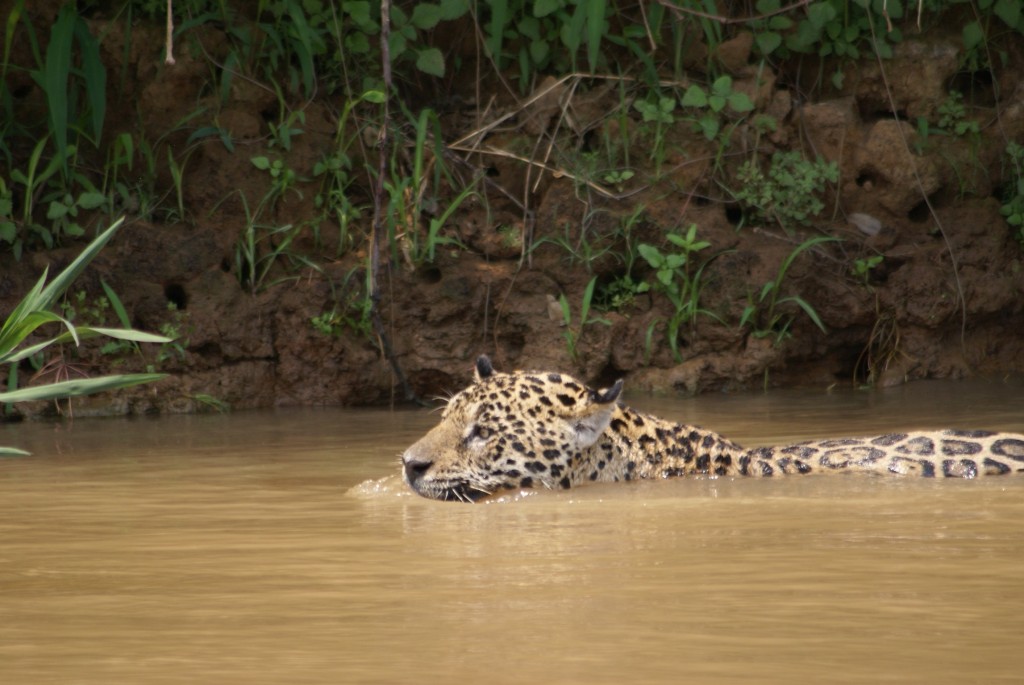
We were sad to leave Porto Jofre Pantanal Norte hotel the next morning. We'd come just to do a river trip and they'd let us stay in their lovely grounds by the river and use their pool, facilities and wifi for nothing. The only stipulation they had was that we took our trips with them and we loved it that much, that we did 3 trips and stayed for 5 nights. Nelson the manager was so friendly and hospitable, we met the lovely couple who owned it as we left and gave them a tour of the truck.
We spent the day slowly driving up the 145km Transpantaneira road and back over the 100 or so rickety wooden bridges, stopping for breakfast, school and lunch. Fortunately some of the worst bridges had small tracks round them, for use in the dry season, so we could go around. We kept our eyes peeled for animals and birds all the way and parked up at the same delightful spot by the road we stayed in on the way down.
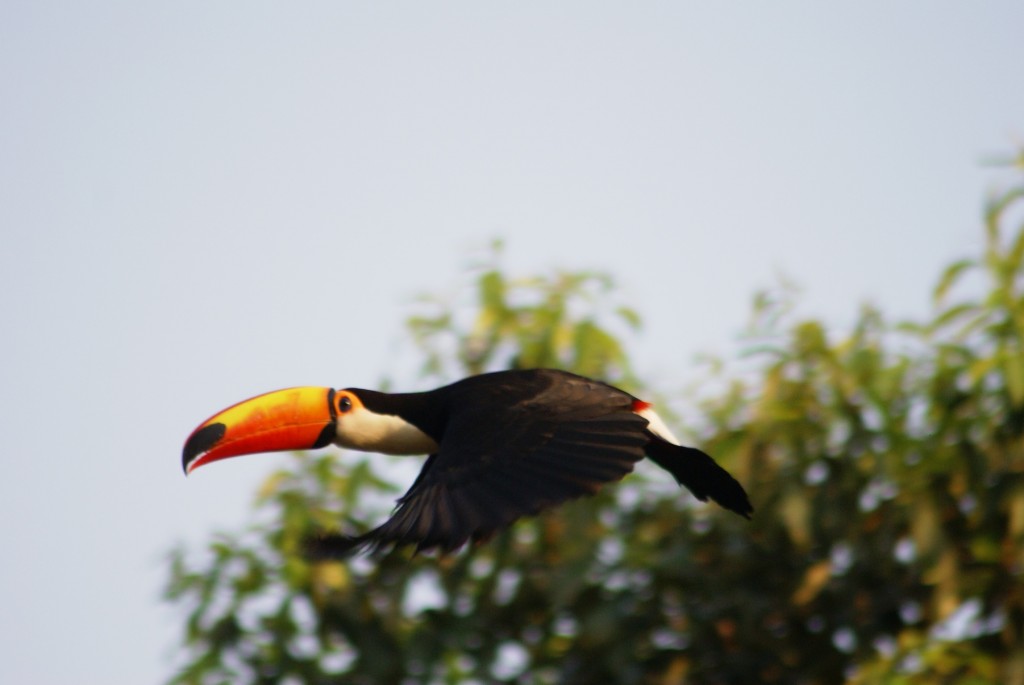
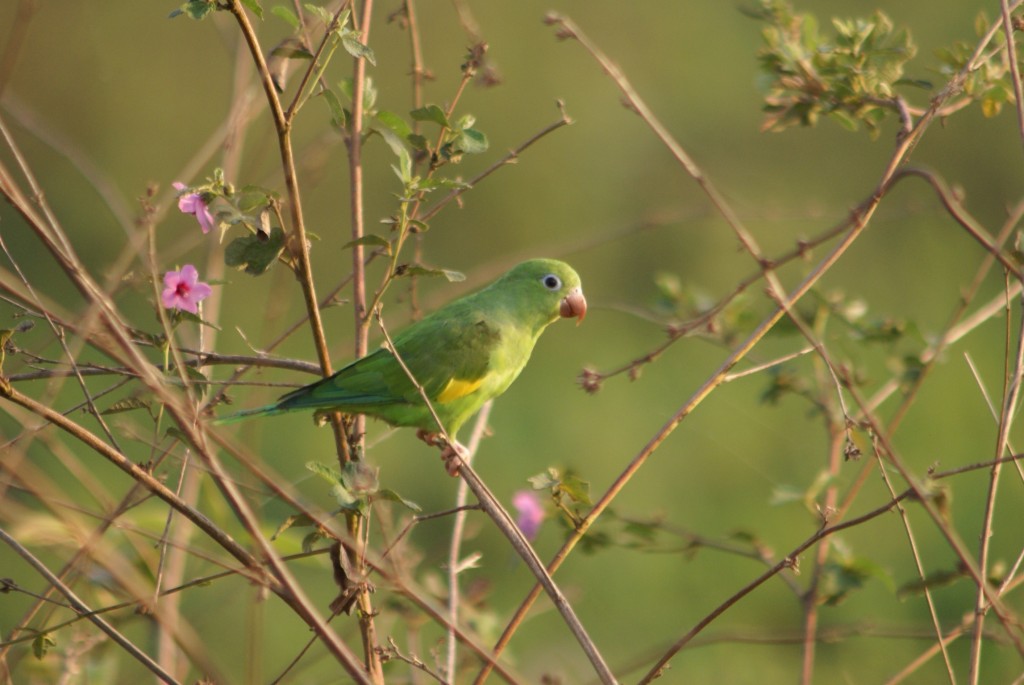
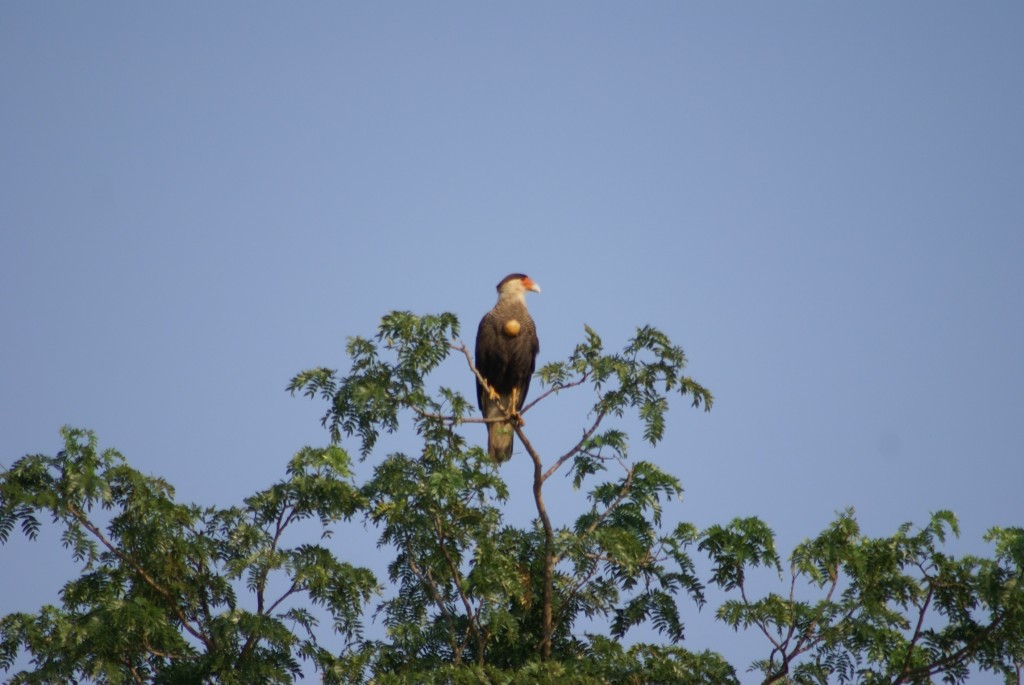
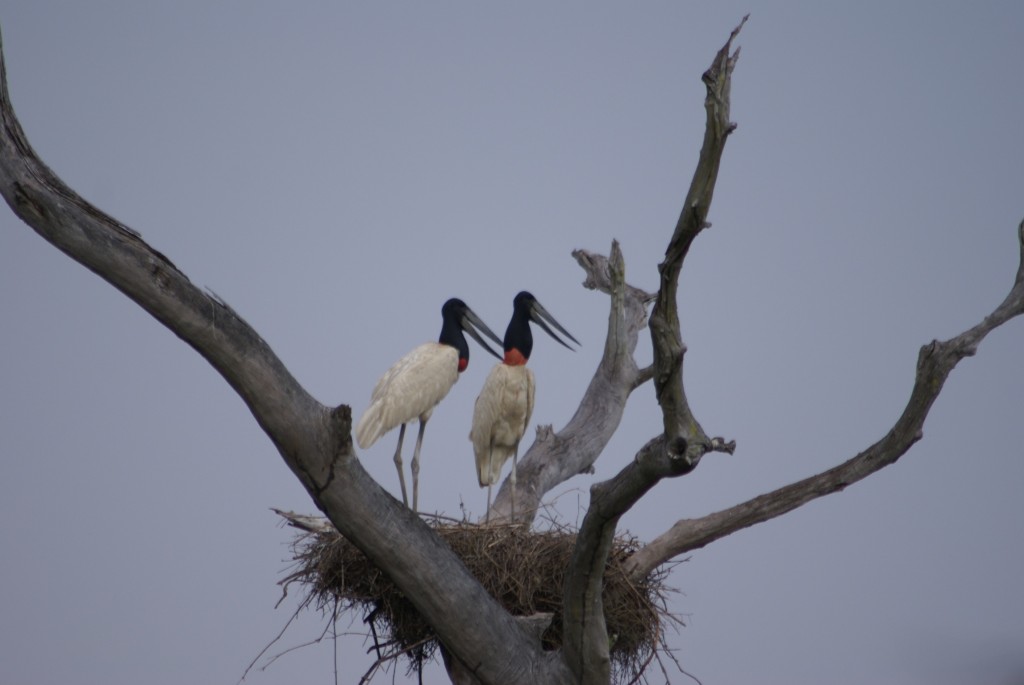
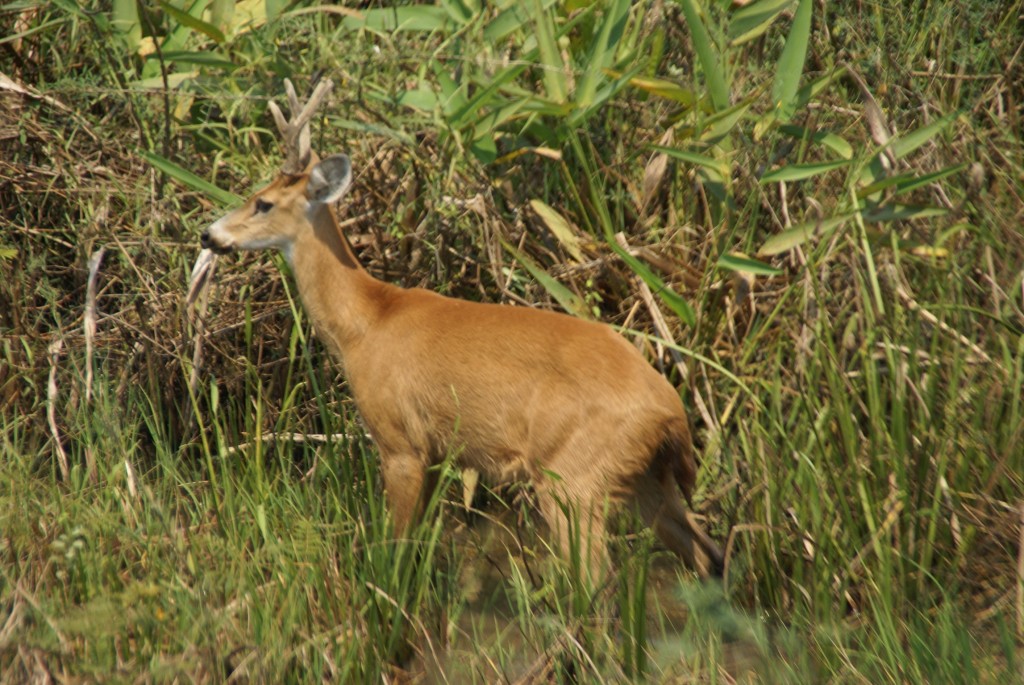
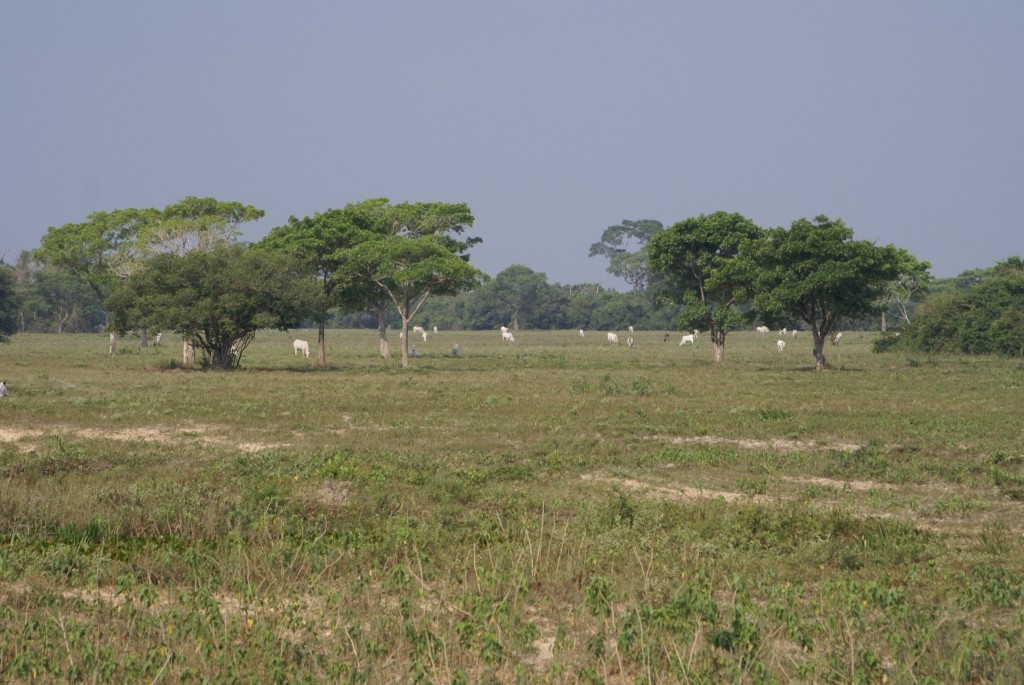
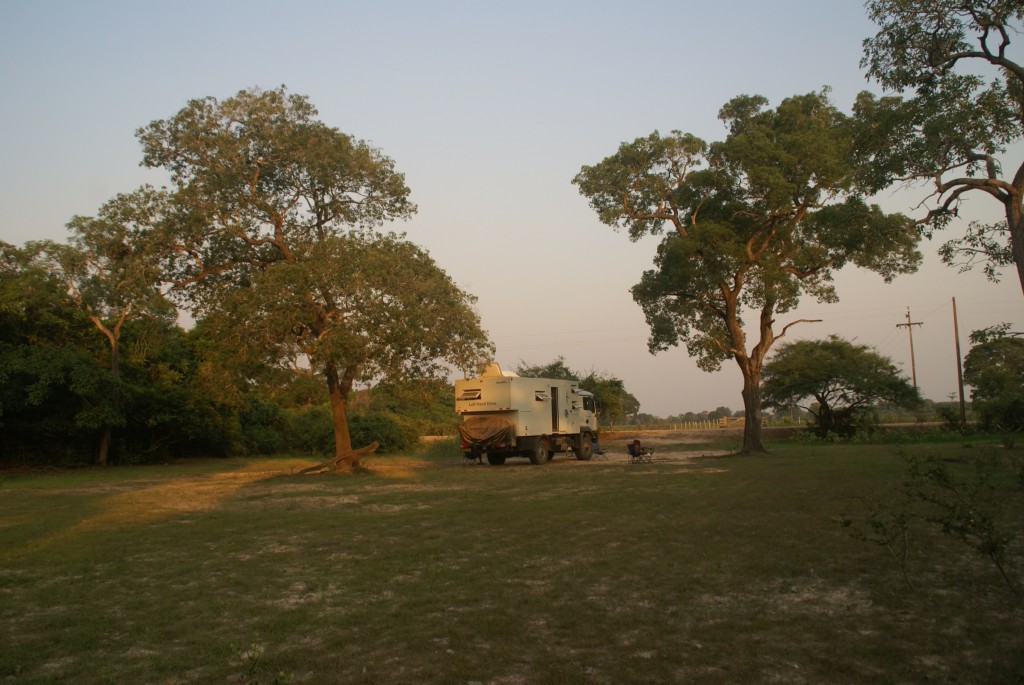
Our following days drive must have been one of our shortest ever to Posada Paradiso, just 10kms away. A working cattle farm with cabins, campspot and, most importantly at this temperature, a pool. It was a lot drier in this part of the Pantanal, with meadows and different types of birds and animals than we'd seen. A peccary wandered into our camp at midday sniffing at the water tap and rhea, the South American ostrich, wandered amongst the cows. The loud squawking from the a huge tree, alerted us to the presence of macaws. At sunset we found a large group both hyacinth and blue macaws flying around the Posada's grounds. Lucy was absolutely thrilled to find a tail feather, longer than her arm, turquoise one one side and yellow on the other.
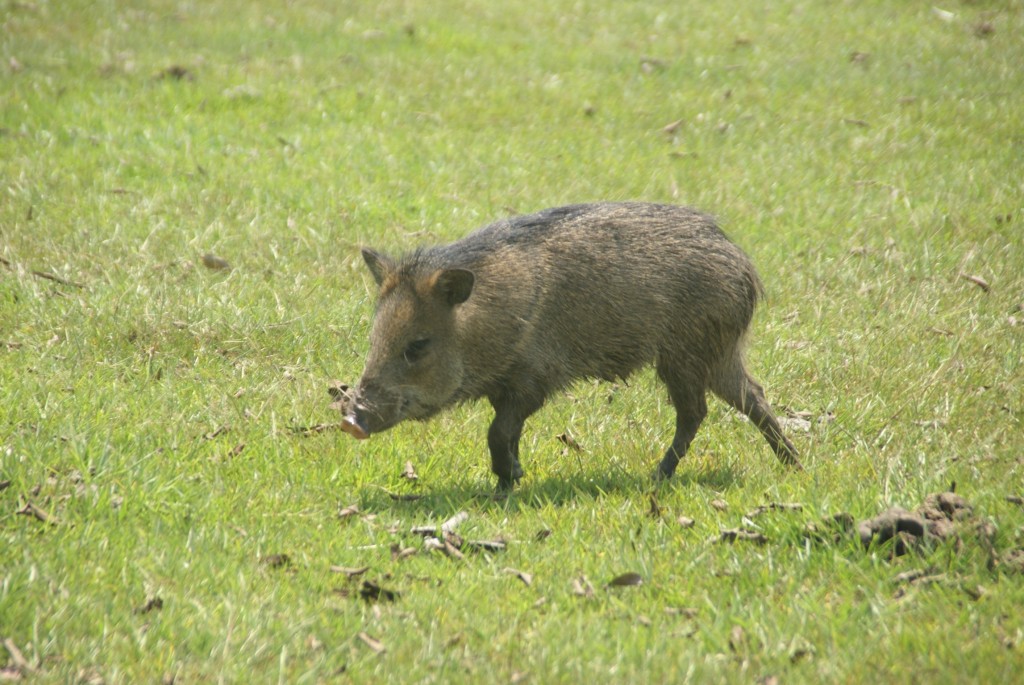
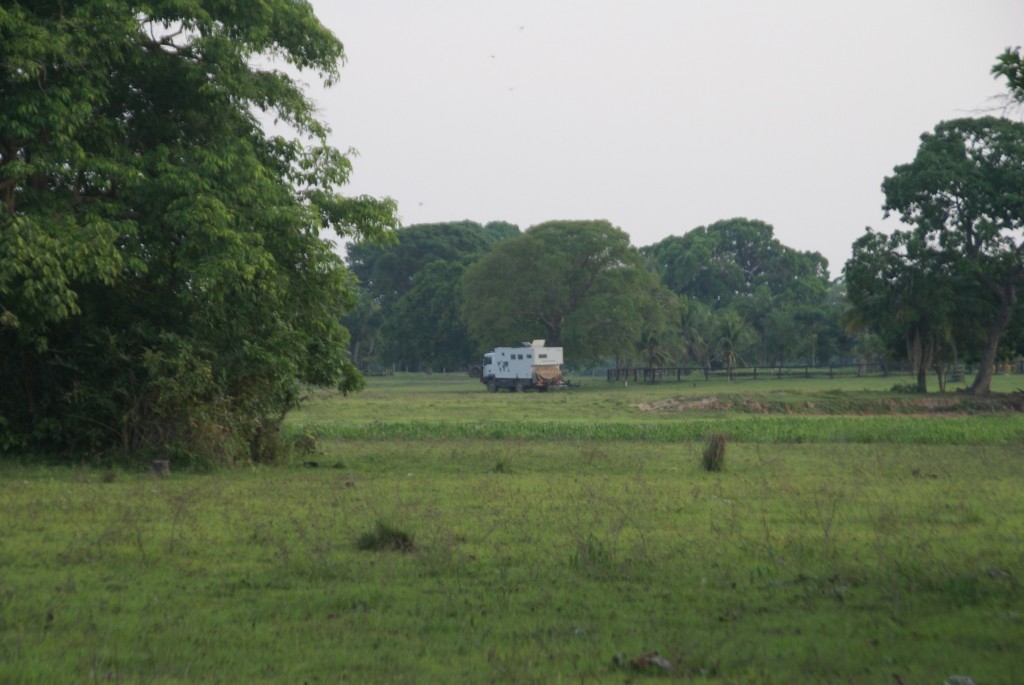
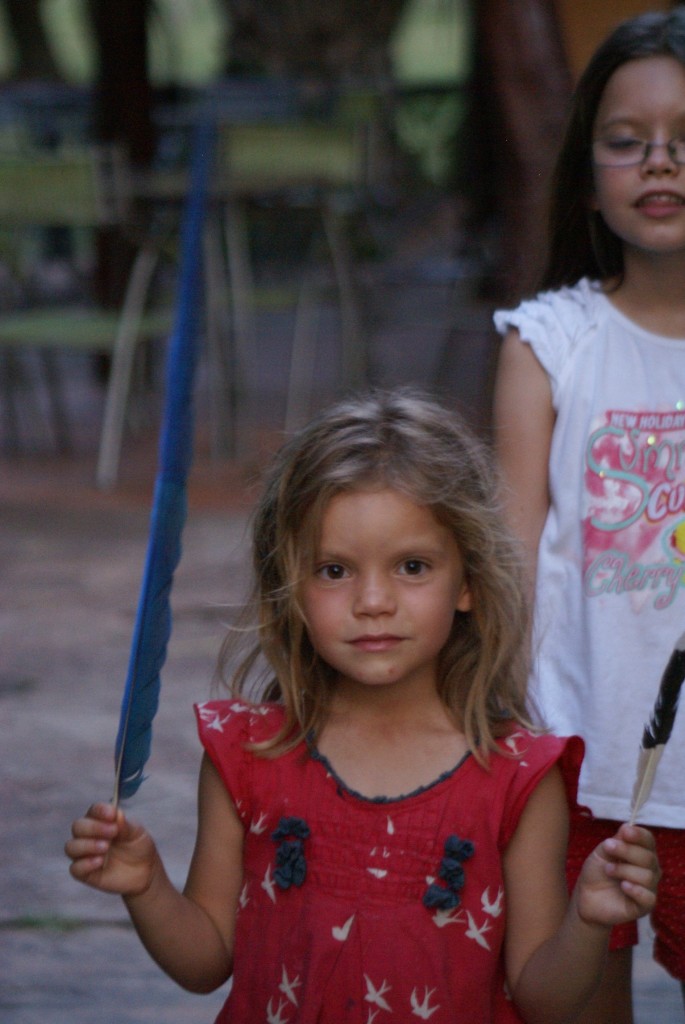
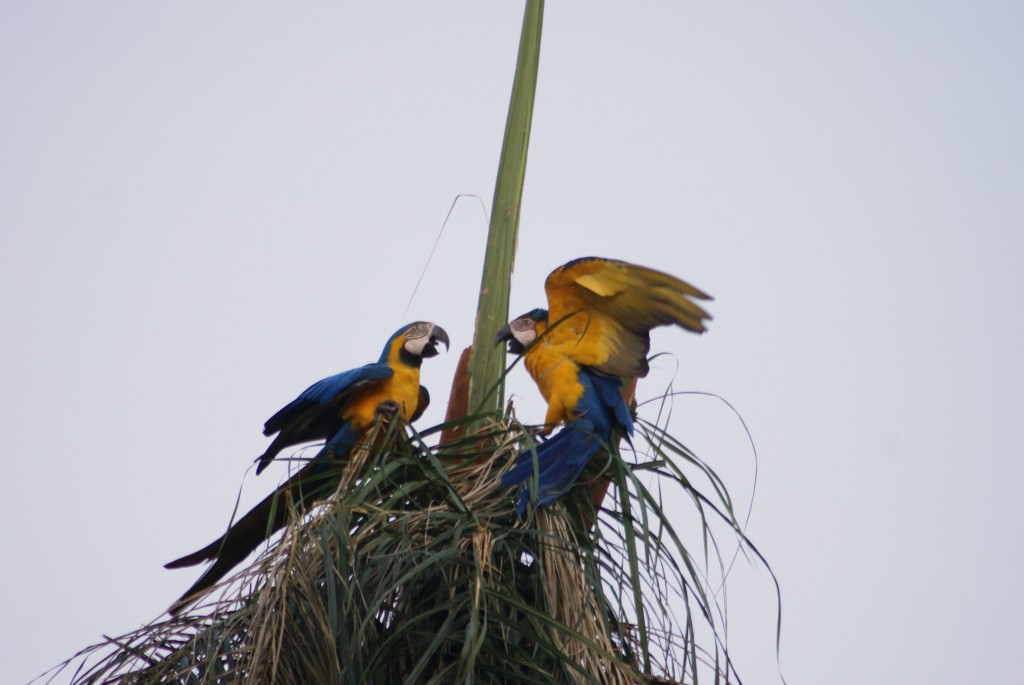
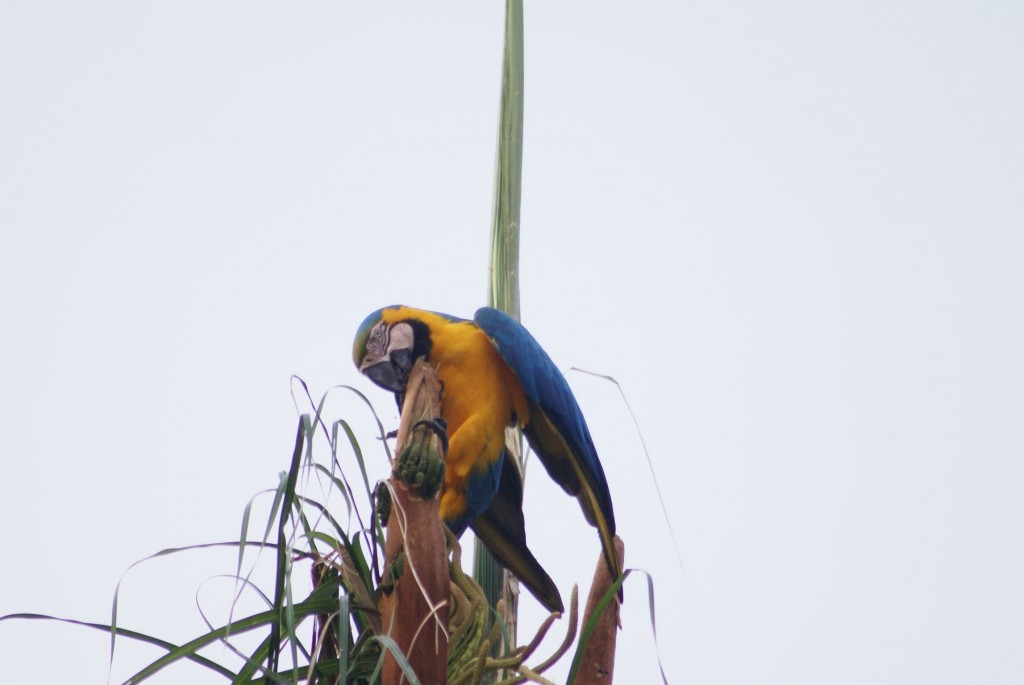
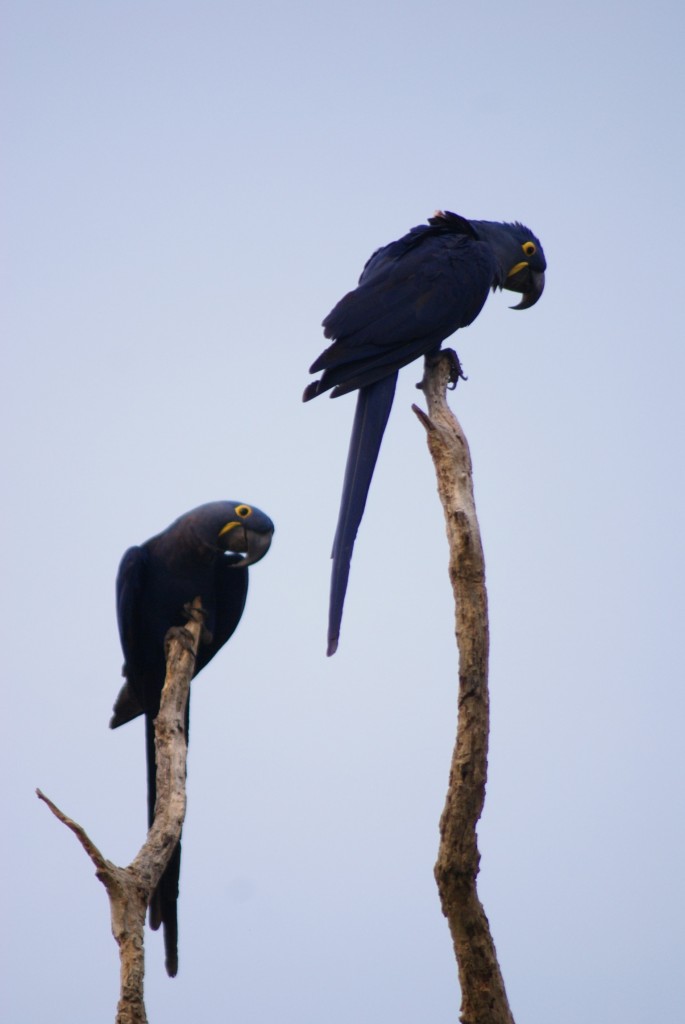
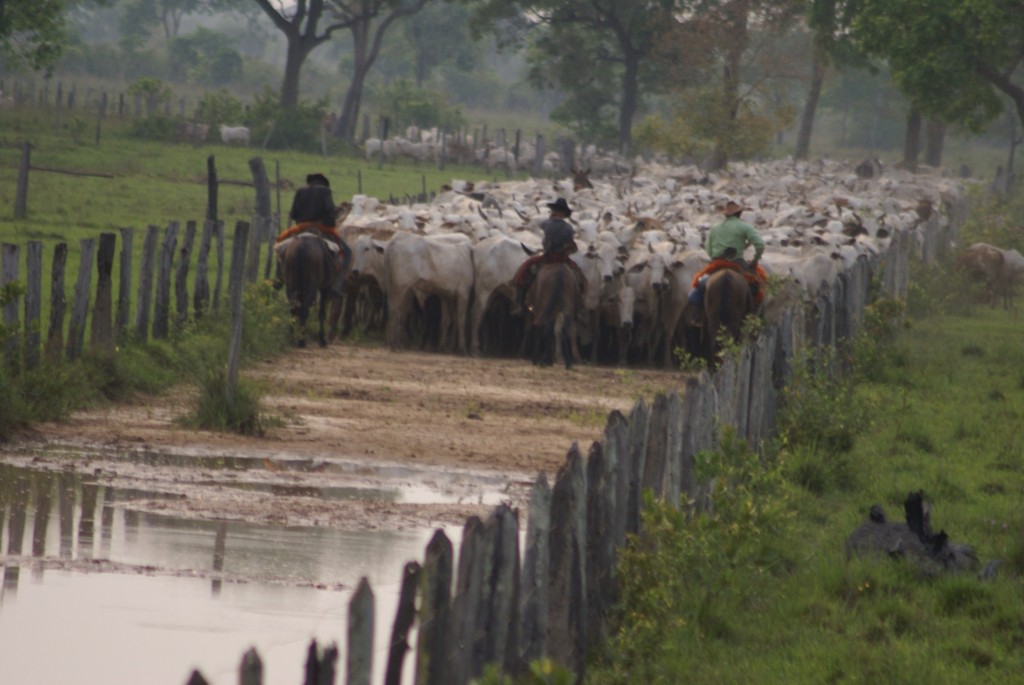
 We started our second day in Porto Jofre in the Pantanal, Brazil, keeping our fingers, and toes, crossed that we might have better luck seeing a jaguar on the boat trip. It is one of the best places and best times of the year to get to see these magnificent beasts. Sharing the boat with a couple of lovely European students who are studying here, we motored up and down the river banks and down smaller tributaries looking for the elusive cat. There were lots of easier to spot animals as well: caimens, capybaras, iguanas and lots of birds. After about 5 hours on the water the boat driver got a call over the radio, a jaguar had been spotted. We set off at speed, hoping to get there before it disappeared into the foliage. The driver enjoyed a "James Bond" moment as he powered the boat through the water hyacinth choked waterways. Once we were close though, he slowed right down as he didn't want to disturb it. At last what we'd been looking for all this time. A big male lazing under a tree, its piercing amber eyes taking in the river and everything or everyone on it. I'm pleased we didn't meet him on foot, when he yawned we got a good look at his killer canines. He looked Iike he'd had a good night hunting with a full belly and now his main priority was trying to keep cool in the relentless heat. We watched him for a couple of hours while he lazed under a tree, always keeping half an eye open. We could see how his spotted rosettes would hide him in the dappled shade but being right on the edge of the bank must have given him a slight breeze.
We started our second day in Porto Jofre in the Pantanal, Brazil, keeping our fingers, and toes, crossed that we might have better luck seeing a jaguar on the boat trip. It is one of the best places and best times of the year to get to see these magnificent beasts. Sharing the boat with a couple of lovely European students who are studying here, we motored up and down the river banks and down smaller tributaries looking for the elusive cat. There were lots of easier to spot animals as well: caimens, capybaras, iguanas and lots of birds. After about 5 hours on the water the boat driver got a call over the radio, a jaguar had been spotted. We set off at speed, hoping to get there before it disappeared into the foliage. The driver enjoyed a "James Bond" moment as he powered the boat through the water hyacinth choked waterways. Once we were close though, he slowed right down as he didn't want to disturb it. At last what we'd been looking for all this time. A big male lazing under a tree, its piercing amber eyes taking in the river and everything or everyone on it. I'm pleased we didn't meet him on foot, when he yawned we got a good look at his killer canines. He looked Iike he'd had a good night hunting with a full belly and now his main priority was trying to keep cool in the relentless heat. We watched him for a couple of hours while he lazed under a tree, always keeping half an eye open. We could see how his spotted rosettes would hide him in the dappled shade but being right on the edge of the bank must have given him a slight breeze.






 We returned happy to our beautiful spot by the river, where we were camping for free in the Hotel Porto Jofre grounds. One of the positive things about 40°C heat was that our massive load of handwashing dried in about half an hour. After our jobs we cooled off in their lovely pool.
We returned happy to our beautiful spot by the river, where we were camping for free in the Hotel Porto Jofre grounds. One of the positive things about 40°C heat was that our massive load of handwashing dried in about half an hour. After our jobs we cooled off in their lovely pool.

 The 5am starts, as well at the baking heat, was starting to wear everyone and their tempers, so we decided to have a more relaxing day. The girls laid in, while I went out in the grounds for sunrise. The amount of birds was astounding, although not a true bird watcher, I couldn't quite decide what to walk over to first: the hyacinth macaws in the palm trees, the jabiru storks by the pond or the yellow weaver birds building their nests by the river.
The 5am starts, as well at the baking heat, was starting to wear everyone and their tempers, so we decided to have a more relaxing day. The girls laid in, while I went out in the grounds for sunrise. The amount of birds was astounding, although not a true bird watcher, I couldn't quite decide what to walk over to first: the hyacinth macaws in the palm trees, the jabiru storks by the pond or the yellow weaver birds building their nests by the river.


 That evening we took another drive out along the road, we had no luck with the animals but watching the sun go down over the marshlands was magical. That evening we escaped the heat and ferocious mosquitoes by eating in the hotel's restaurant. We've had to abandon cooking anything in the truck as it takes the temperature inside from oven to furnace, so we are using the Cobb barbecue outside for everything.
That evening we took another drive out along the road, we had no luck with the animals but watching the sun go down over the marshlands was magical. That evening we escaped the heat and ferocious mosquitoes by eating in the hotel's restaurant. We've had to abandon cooking anything in the truck as it takes the temperature inside from oven to furnace, so we are using the Cobb barbecue outside for everything.
 After another 5am start the following day for a 7 hour trip on the river, we were rewarded early on with a family of about 10 giant river otters. There were about 6 juveniles who were in a very playful mood. After watching them hunt and hearing them noisily crunch through the fish they had caught, we watched them play. We had stopped next to a small floating island of reeds a respectful distance away, but we were so lucky as they came to wrestle with each other on the island right next to us. Like children everywhere they tussled, snuck up on each other and tumbled around. It was hard to tell which otter was which as they became a tumbling mass of sleek, brown, furry bodies.
After another 5am start the following day for a 7 hour trip on the river, we were rewarded early on with a family of about 10 giant river otters. There were about 6 juveniles who were in a very playful mood. After watching them hunt and hearing them noisily crunch through the fish they had caught, we watched them play. We had stopped next to a small floating island of reeds a respectful distance away, but we were so lucky as they came to wrestle with each other on the island right next to us. Like children everywhere they tussled, snuck up on each other and tumbled around. It was hard to tell which otter was which as they became a tumbling mass of sleek, brown, furry bodies.



 After the otters had swam off, we were off again searching for jaguars. We were so lucky and managed to see three during the morning. The first was another big male, he sauntered along the riverbank looking every inch the top carnivore he is. However he soon settled down for a deep sleep under a bush almost disappearing from view in the deep shade. The second we found looking out over the river but soon moved off into the deep bush. Jaguars here sleep on the banks of the river during the day as it is a little cooler, which is why they are easier to see here than many places. Our third siting was amazing. We saw the long grass on the riverbank sway and ripple way before we saw what was causing it. We figured it had to be something big and powerful with the way the grass was moving. We were absolutely right it was a big strapping male, well fed and in his prime. He was moving with purpose at the edge of the river, through the long grass. When it got too steep he plunged into the muddy brown waters. He paddled his way along the shoreline. I knew jaguars could swim but didn't realise they were as agile in the water as they are on land. Striding in and out of the water, he was obviously looking for something. We followed him for about half an hour as he moved upstream hunting for caimans. Twice there was a huge splash from the grassy edge as panicking caimans launched themselves into the water, just in time to escape from the jaguar's jaws. We knew this must be something very special when our boat driver started taking a video on his mobile phone. Disappearing again into the long grass, the vegetation quivered and oscillated as the huge head and powerful shoulders parted through it. Suddenly there was an almighty splash and frantic crashing from the grass, silence, then some more thrashes and the sound of a final writhing. Standing on our tiptoes we could see the stilled back of a big caiman and the panting jaguar. Our last view of the magnificent beast was the rather undignified view of his backside as he was humping his overweight pray away from the river's edge. We couldn't believe how lucky we had been to see this so rare and elusive animal in its natural environment, hunting. We kept on recounting parts of what we'd seen to each other all day, not quite believing what we'd witnessed.
After the otters had swam off, we were off again searching for jaguars. We were so lucky and managed to see three during the morning. The first was another big male, he sauntered along the riverbank looking every inch the top carnivore he is. However he soon settled down for a deep sleep under a bush almost disappearing from view in the deep shade. The second we found looking out over the river but soon moved off into the deep bush. Jaguars here sleep on the banks of the river during the day as it is a little cooler, which is why they are easier to see here than many places. Our third siting was amazing. We saw the long grass on the riverbank sway and ripple way before we saw what was causing it. We figured it had to be something big and powerful with the way the grass was moving. We were absolutely right it was a big strapping male, well fed and in his prime. He was moving with purpose at the edge of the river, through the long grass. When it got too steep he plunged into the muddy brown waters. He paddled his way along the shoreline. I knew jaguars could swim but didn't realise they were as agile in the water as they are on land. Striding in and out of the water, he was obviously looking for something. We followed him for about half an hour as he moved upstream hunting for caimans. Twice there was a huge splash from the grassy edge as panicking caimans launched themselves into the water, just in time to escape from the jaguar's jaws. We knew this must be something very special when our boat driver started taking a video on his mobile phone. Disappearing again into the long grass, the vegetation quivered and oscillated as the huge head and powerful shoulders parted through it. Suddenly there was an almighty splash and frantic crashing from the grass, silence, then some more thrashes and the sound of a final writhing. Standing on our tiptoes we could see the stilled back of a big caiman and the panting jaguar. Our last view of the magnificent beast was the rather undignified view of his backside as he was humping his overweight pray away from the river's edge. We couldn't believe how lucky we had been to see this so rare and elusive animal in its natural environment, hunting. We kept on recounting parts of what we'd seen to each other all day, not quite believing what we'd witnessed. 





 We were sad to leave Porto Jofre Pantanal Norte hotel the next morning. We'd come just to do a river trip and they'd let us stay in their lovely grounds by the river and use their pool, facilities and wifi for nothing. The only stipulation they had was that we took our trips with them and we loved it that much, that we did 3 trips and stayed for 5 nights. Nelson the manager was so friendly and hospitable, we met the lovely couple who owned it as we left and gave them a tour of the truck.
We spent the day slowly driving up the 145km Transpantaneira road and back over the 100 or so rickety wooden bridges, stopping for breakfast, school and lunch. Fortunately some of the worst bridges had small tracks round them, for use in the dry season, so we could go around. We kept our eyes peeled for animals and birds all the way and parked up at the same delightful spot by the road we stayed in on the way down.
We were sad to leave Porto Jofre Pantanal Norte hotel the next morning. We'd come just to do a river trip and they'd let us stay in their lovely grounds by the river and use their pool, facilities and wifi for nothing. The only stipulation they had was that we took our trips with them and we loved it that much, that we did 3 trips and stayed for 5 nights. Nelson the manager was so friendly and hospitable, we met the lovely couple who owned it as we left and gave them a tour of the truck.
We spent the day slowly driving up the 145km Transpantaneira road and back over the 100 or so rickety wooden bridges, stopping for breakfast, school and lunch. Fortunately some of the worst bridges had small tracks round them, for use in the dry season, so we could go around. We kept our eyes peeled for animals and birds all the way and parked up at the same delightful spot by the road we stayed in on the way down. 





 Our following days drive must have been one of our shortest ever to Posada Paradiso, just 10kms away. A working cattle farm with cabins, campspot and, most importantly at this temperature, a pool. It was a lot drier in this part of the Pantanal, with meadows and different types of birds and animals than we'd seen. A peccary wandered into our camp at midday sniffing at the water tap and rhea, the South American ostrich, wandered amongst the cows. The loud squawking from the a huge tree, alerted us to the presence of macaws. At sunset we found a large group both hyacinth and blue macaws flying around the Posada's grounds. Lucy was absolutely thrilled to find a tail feather, longer than her arm, turquoise one one side and yellow on the other.
Our following days drive must have been one of our shortest ever to Posada Paradiso, just 10kms away. A working cattle farm with cabins, campspot and, most importantly at this temperature, a pool. It was a lot drier in this part of the Pantanal, with meadows and different types of birds and animals than we'd seen. A peccary wandered into our camp at midday sniffing at the water tap and rhea, the South American ostrich, wandered amongst the cows. The loud squawking from the a huge tree, alerted us to the presence of macaws. At sunset we found a large group both hyacinth and blue macaws flying around the Posada's grounds. Lucy was absolutely thrilled to find a tail feather, longer than her arm, turquoise one one side and yellow on the other.







